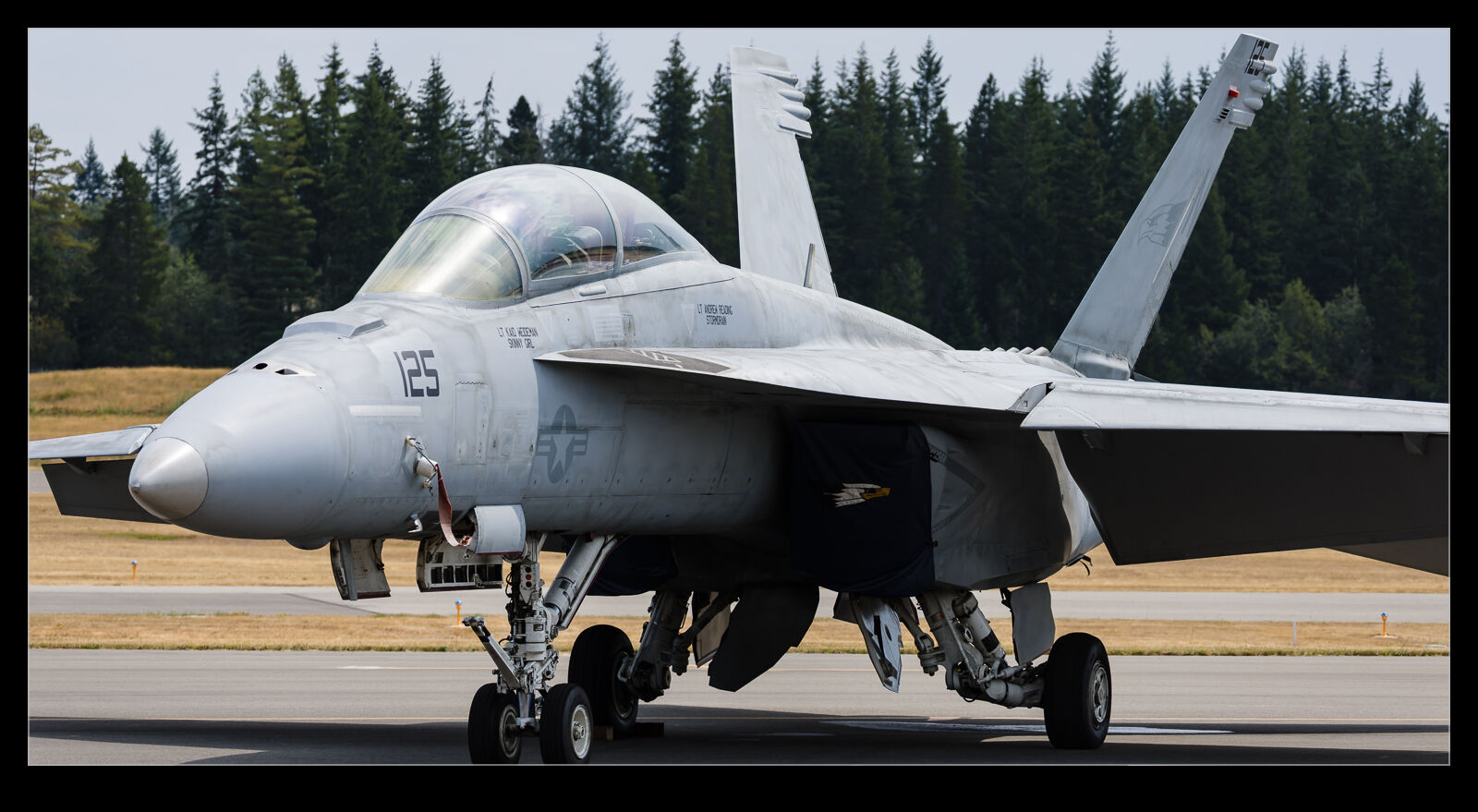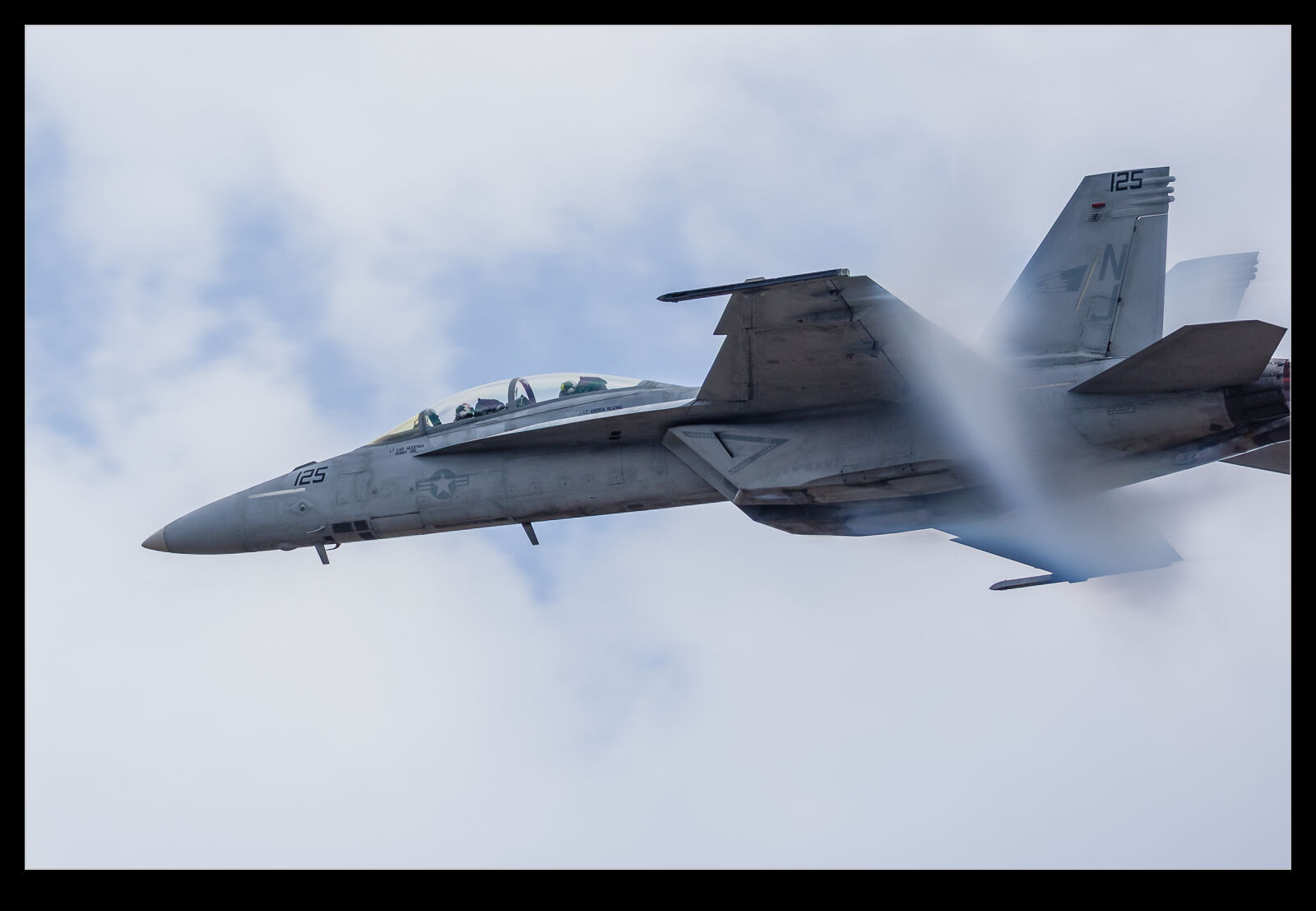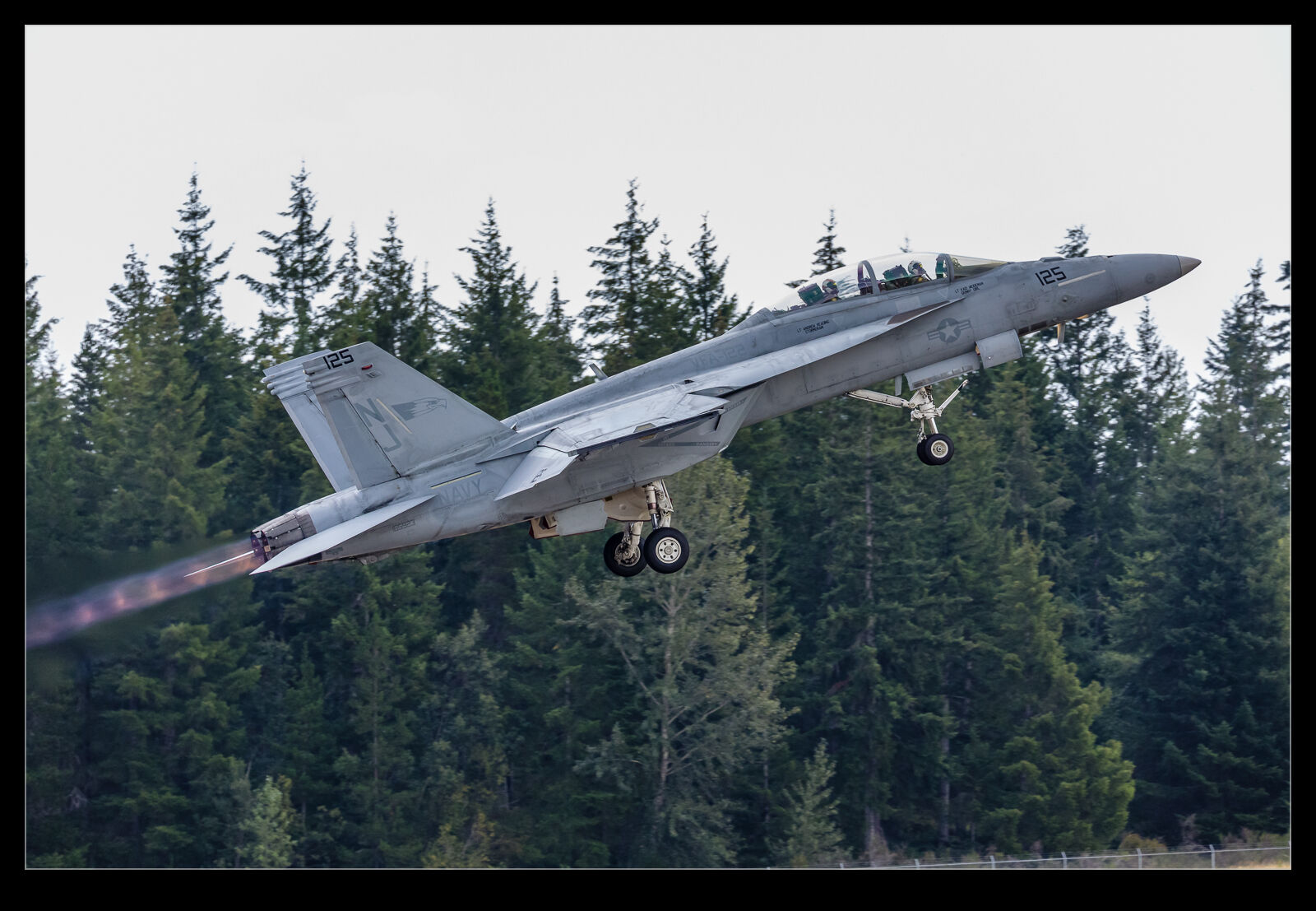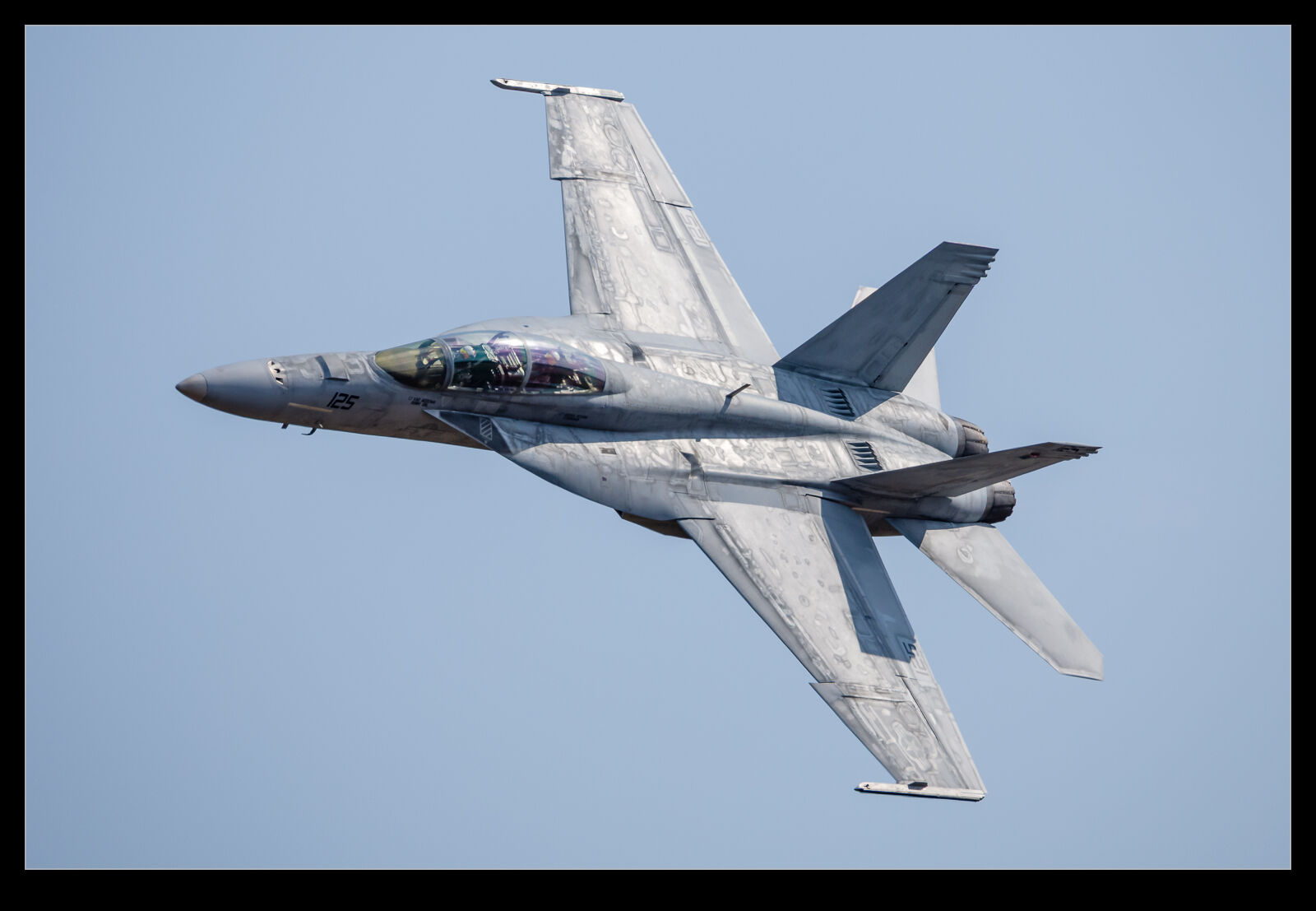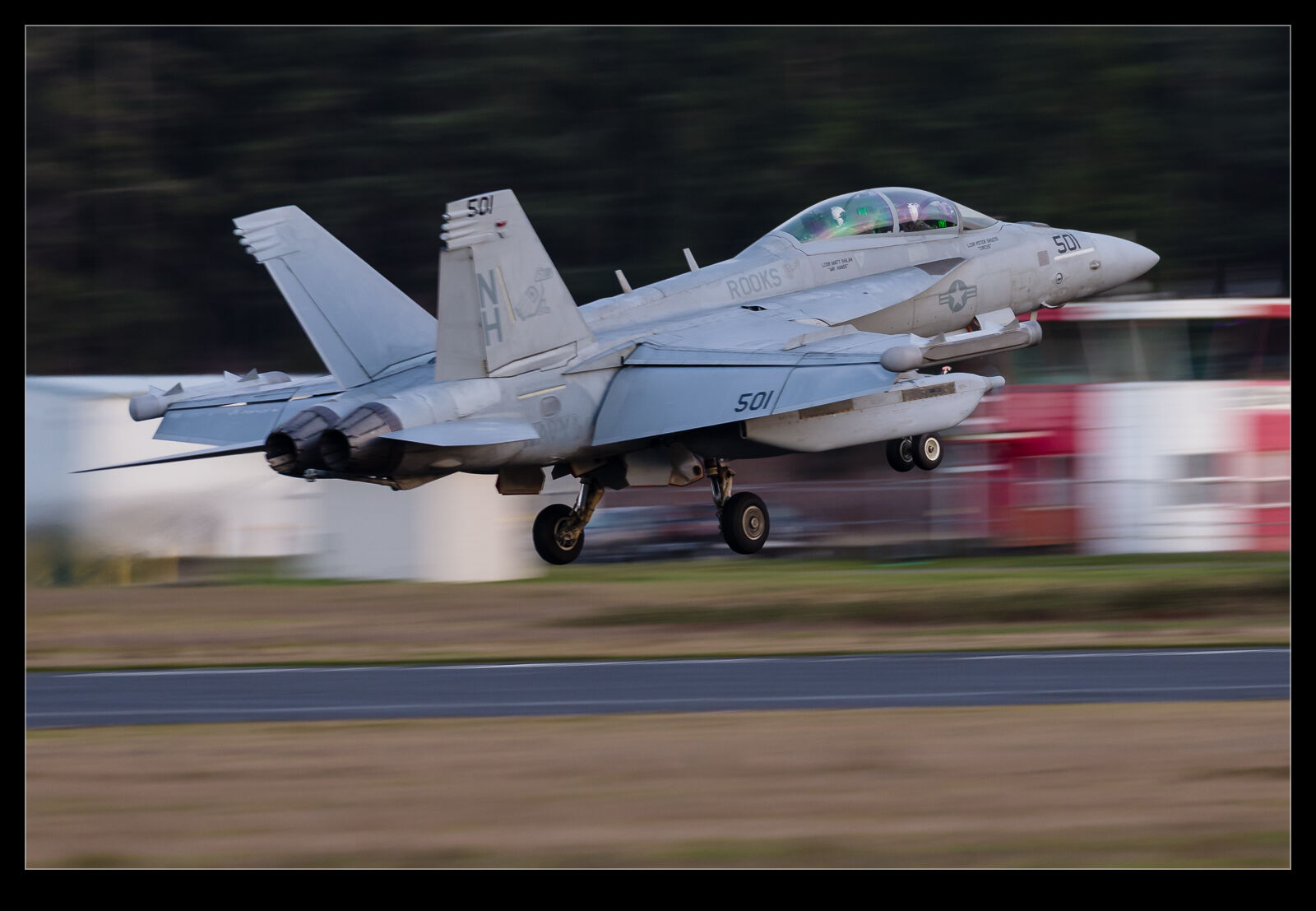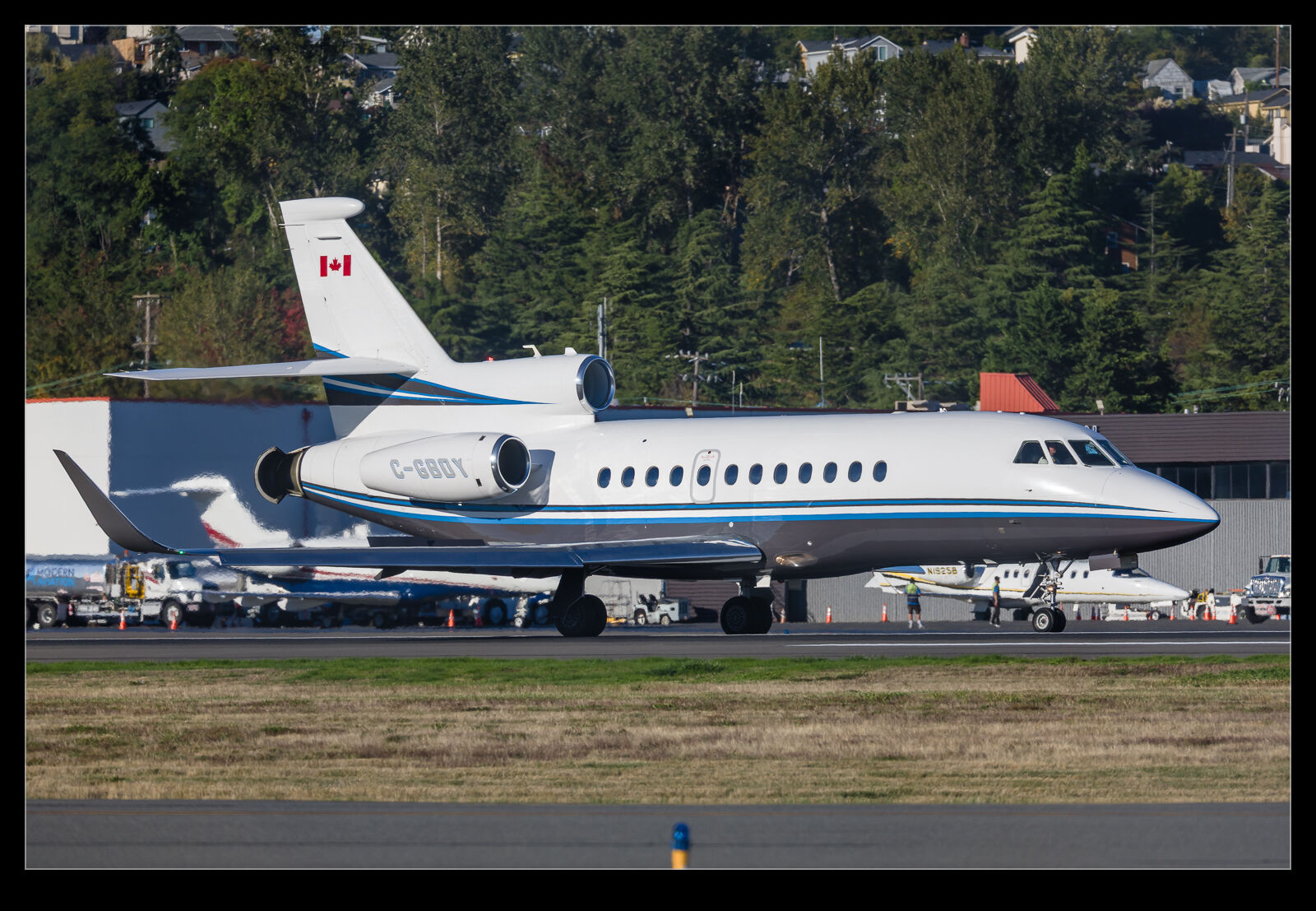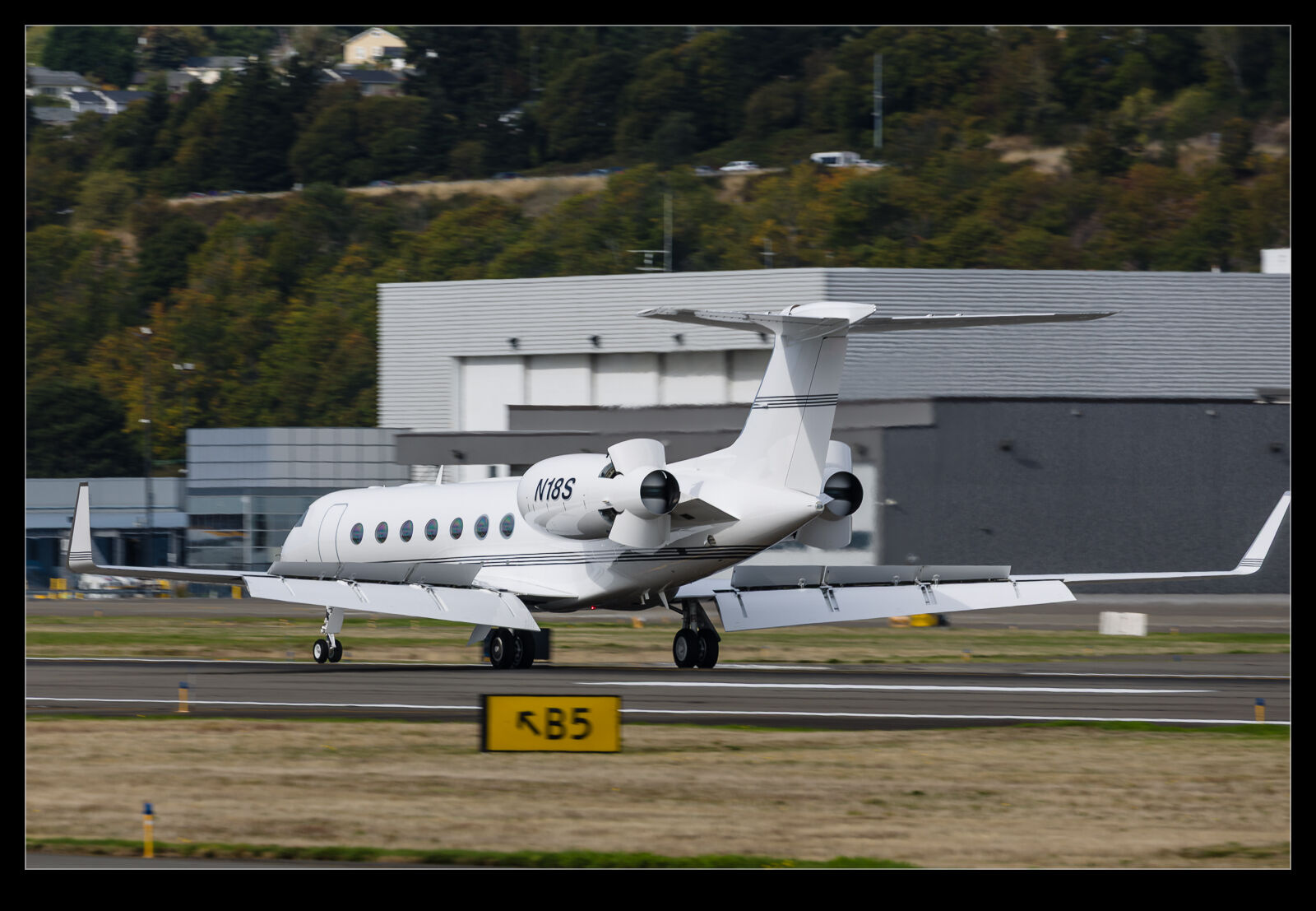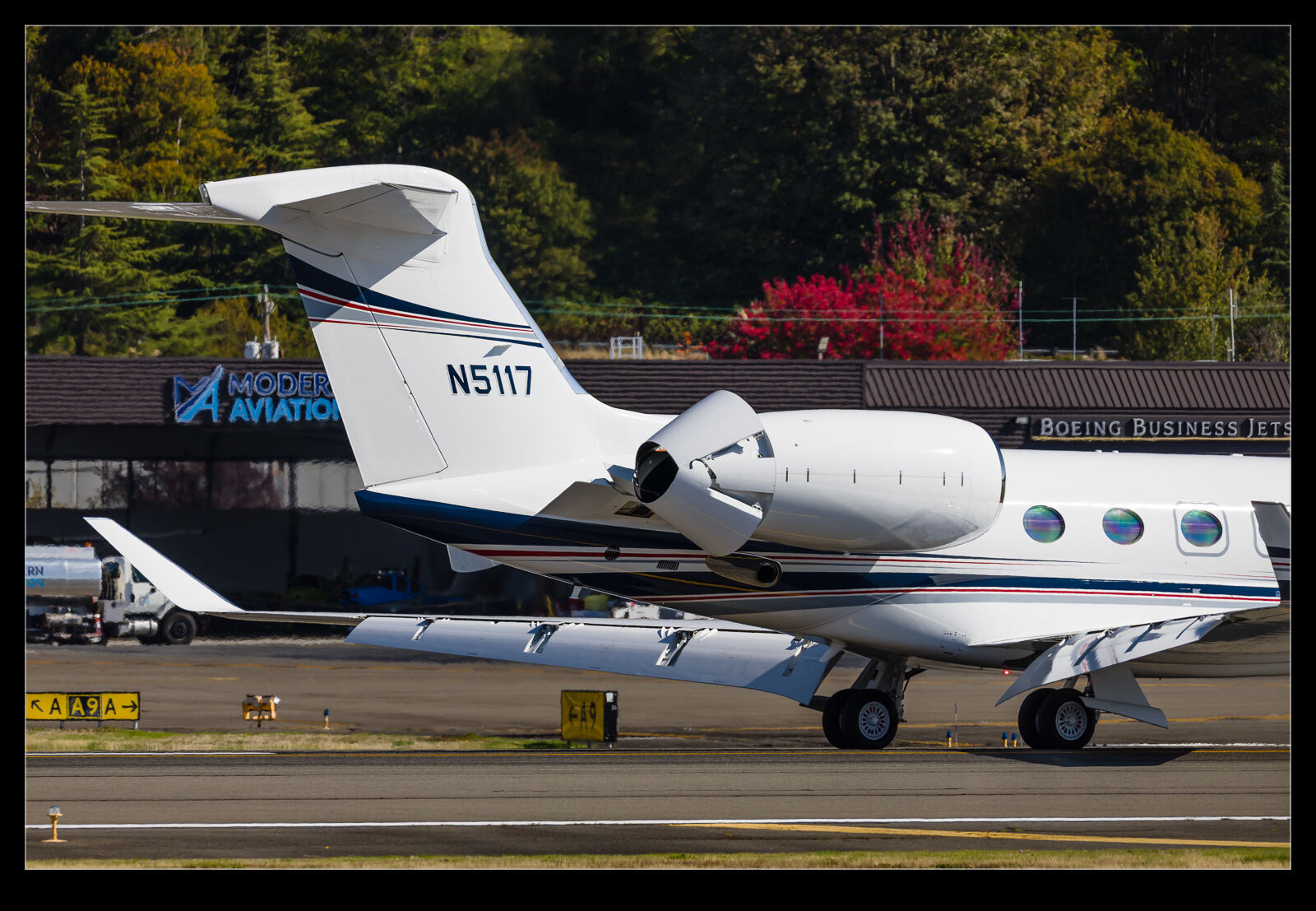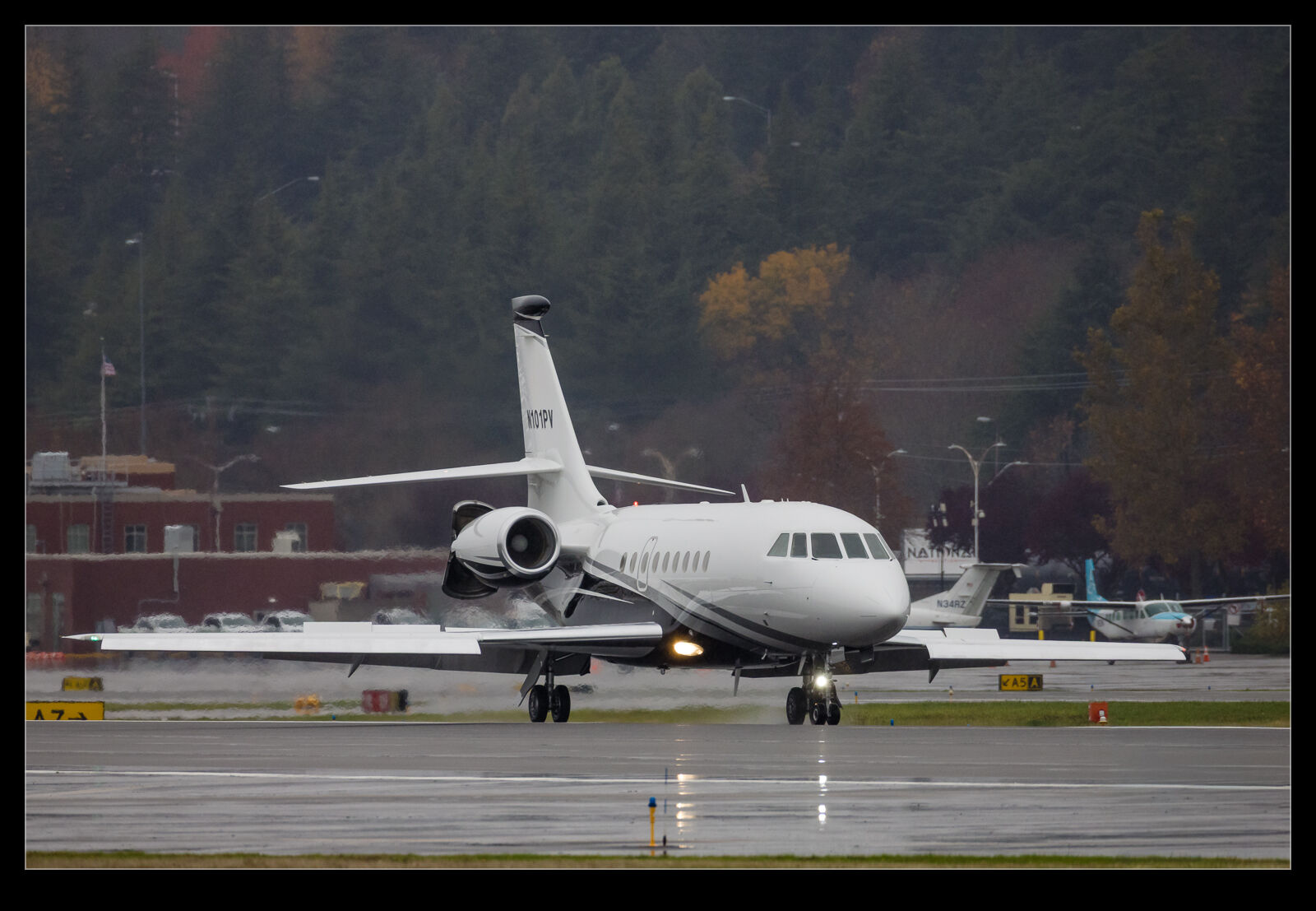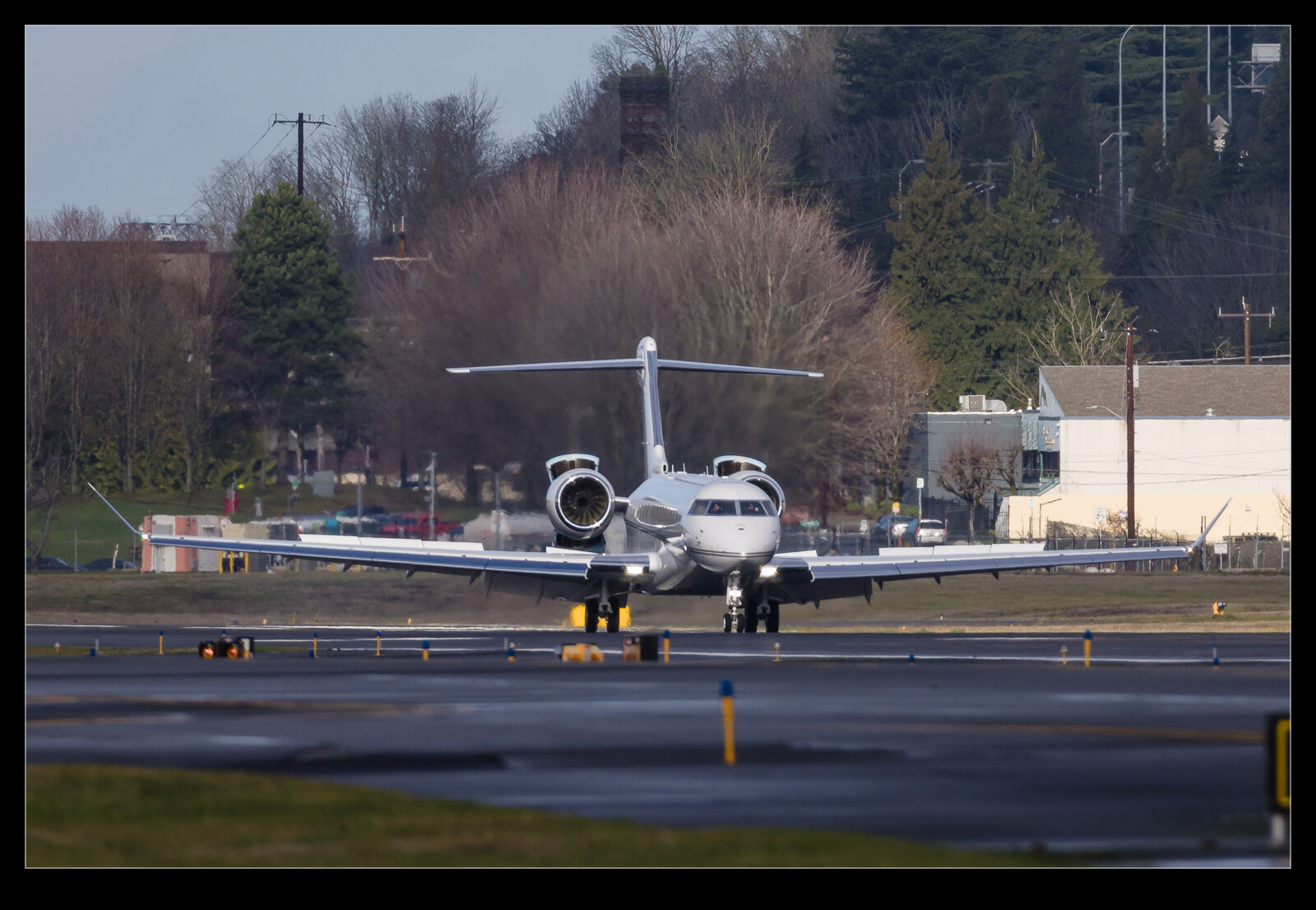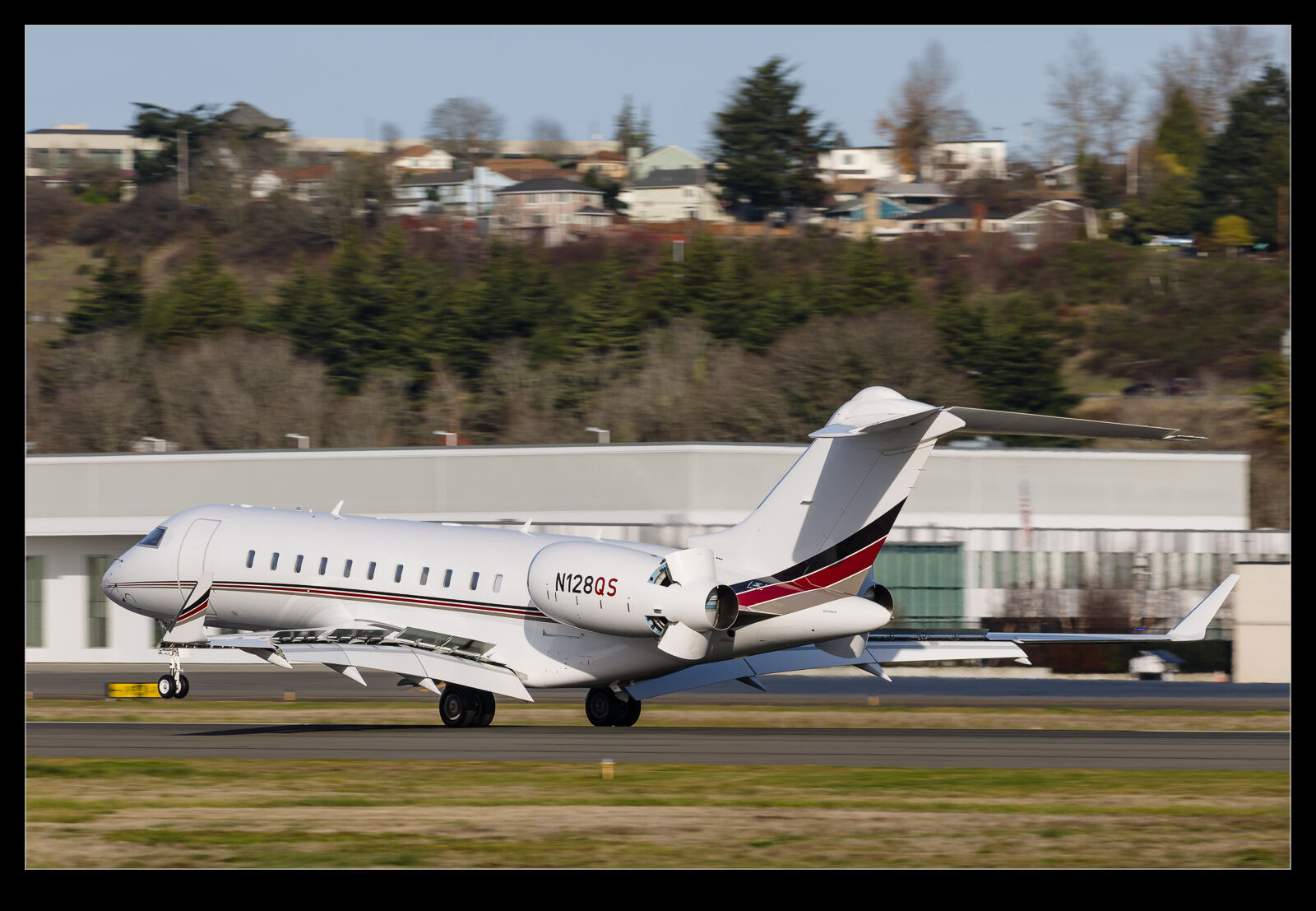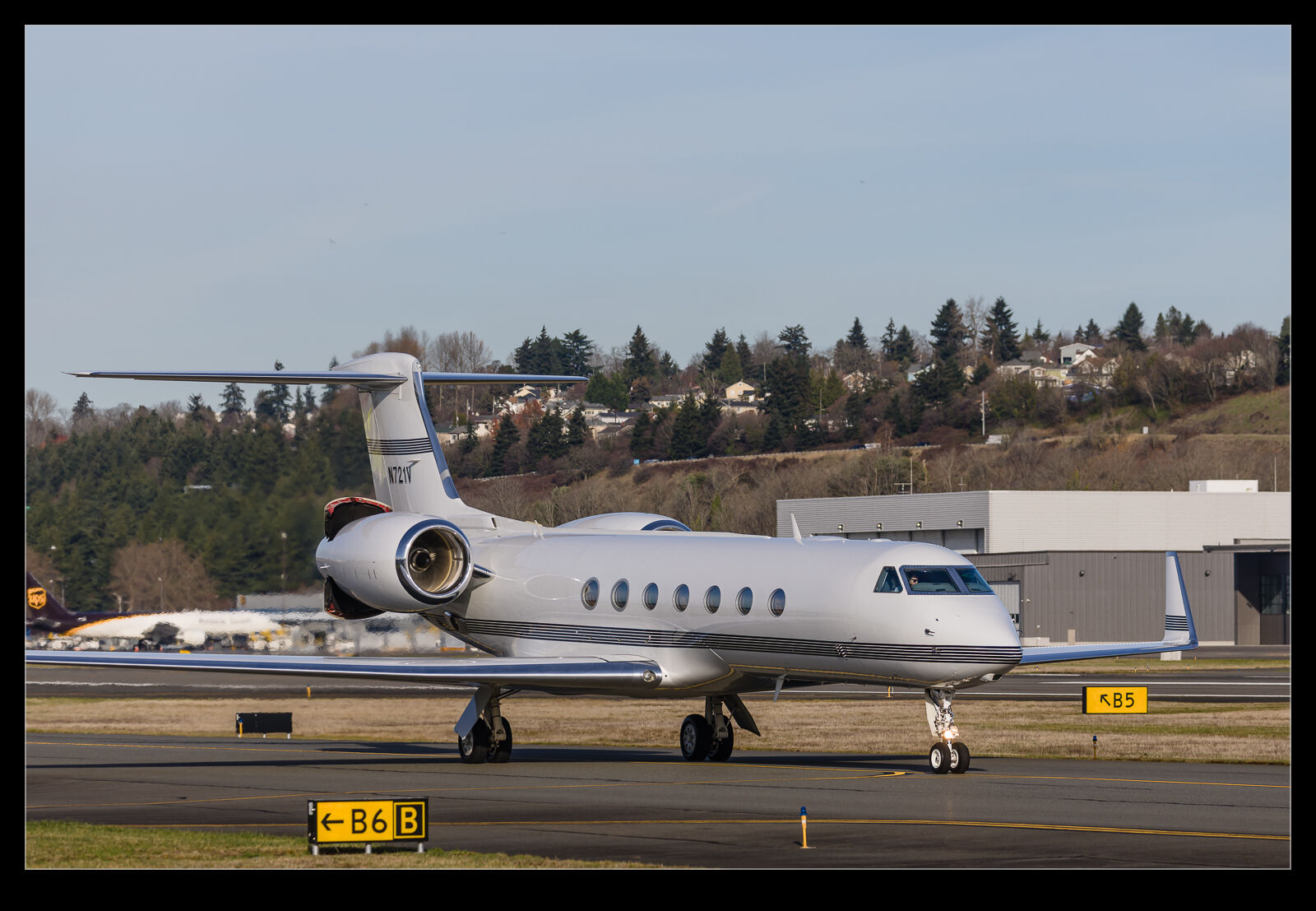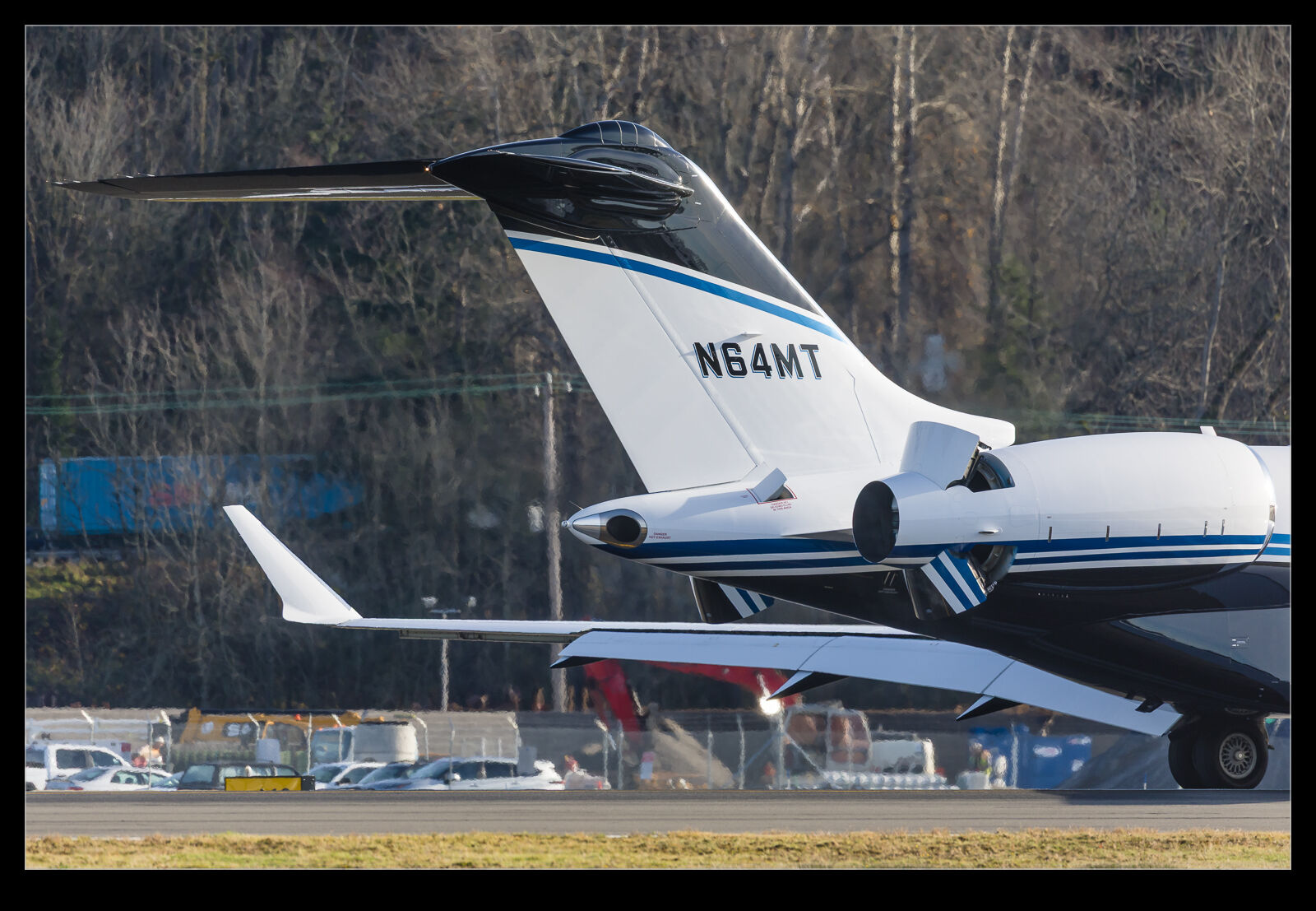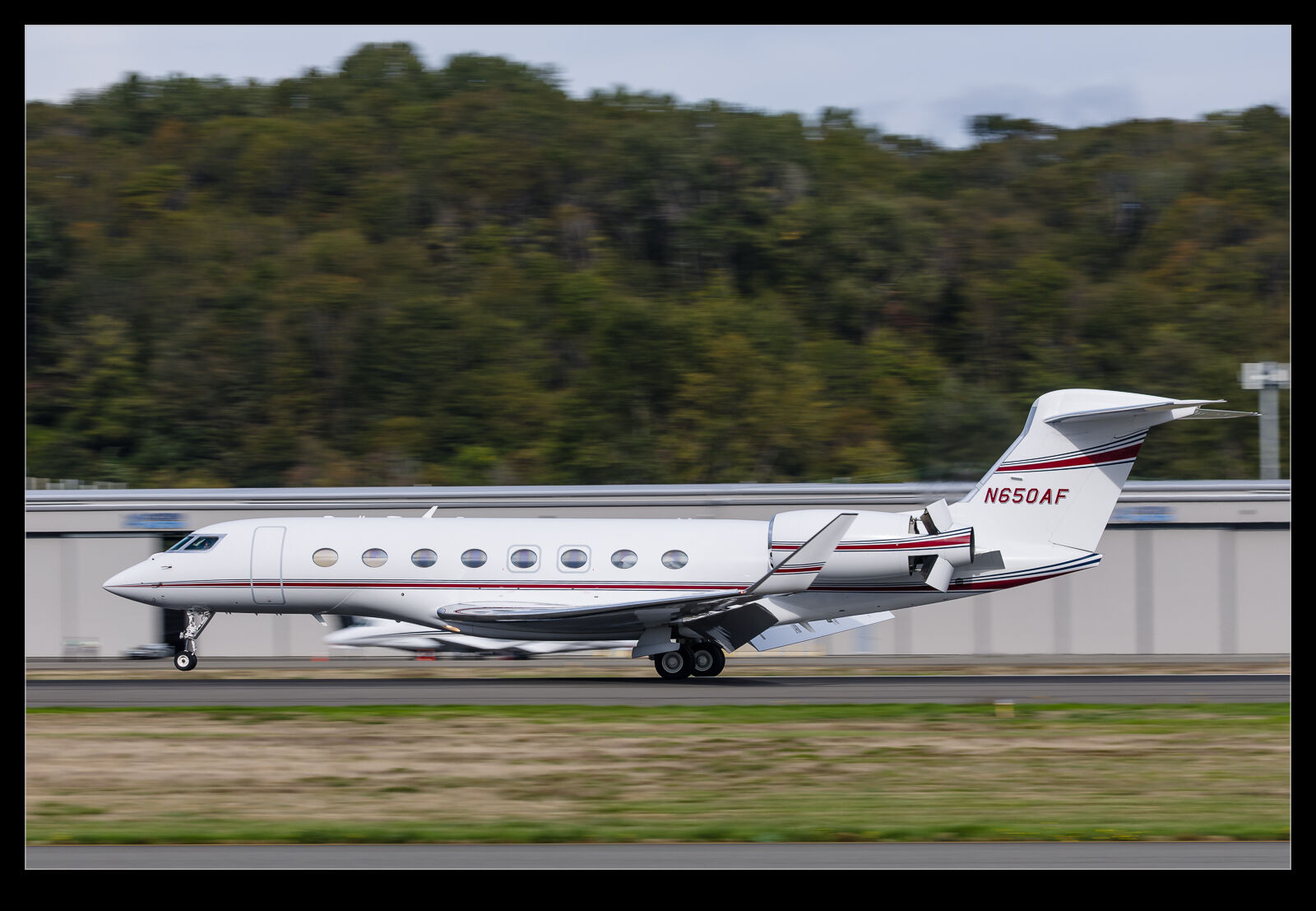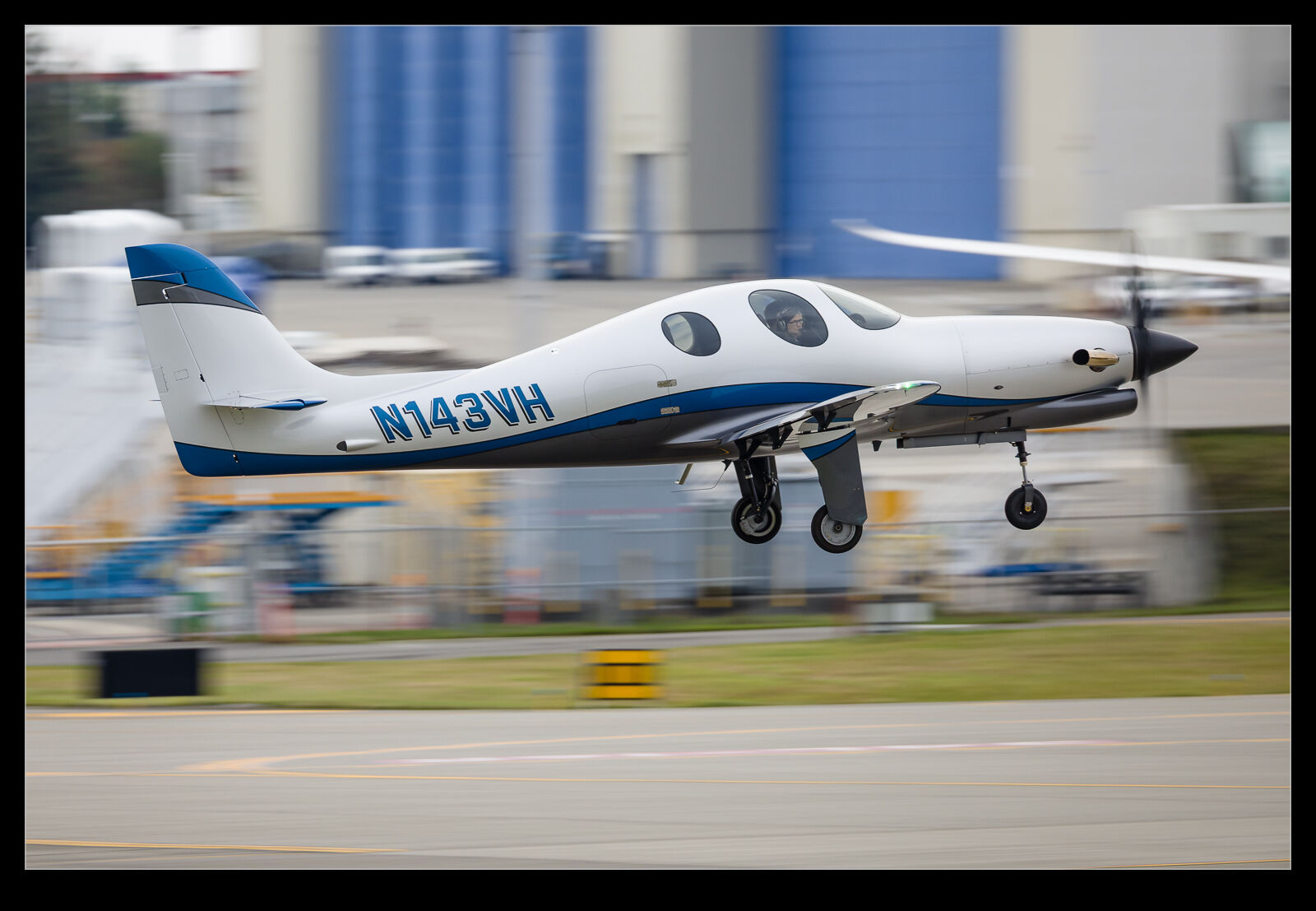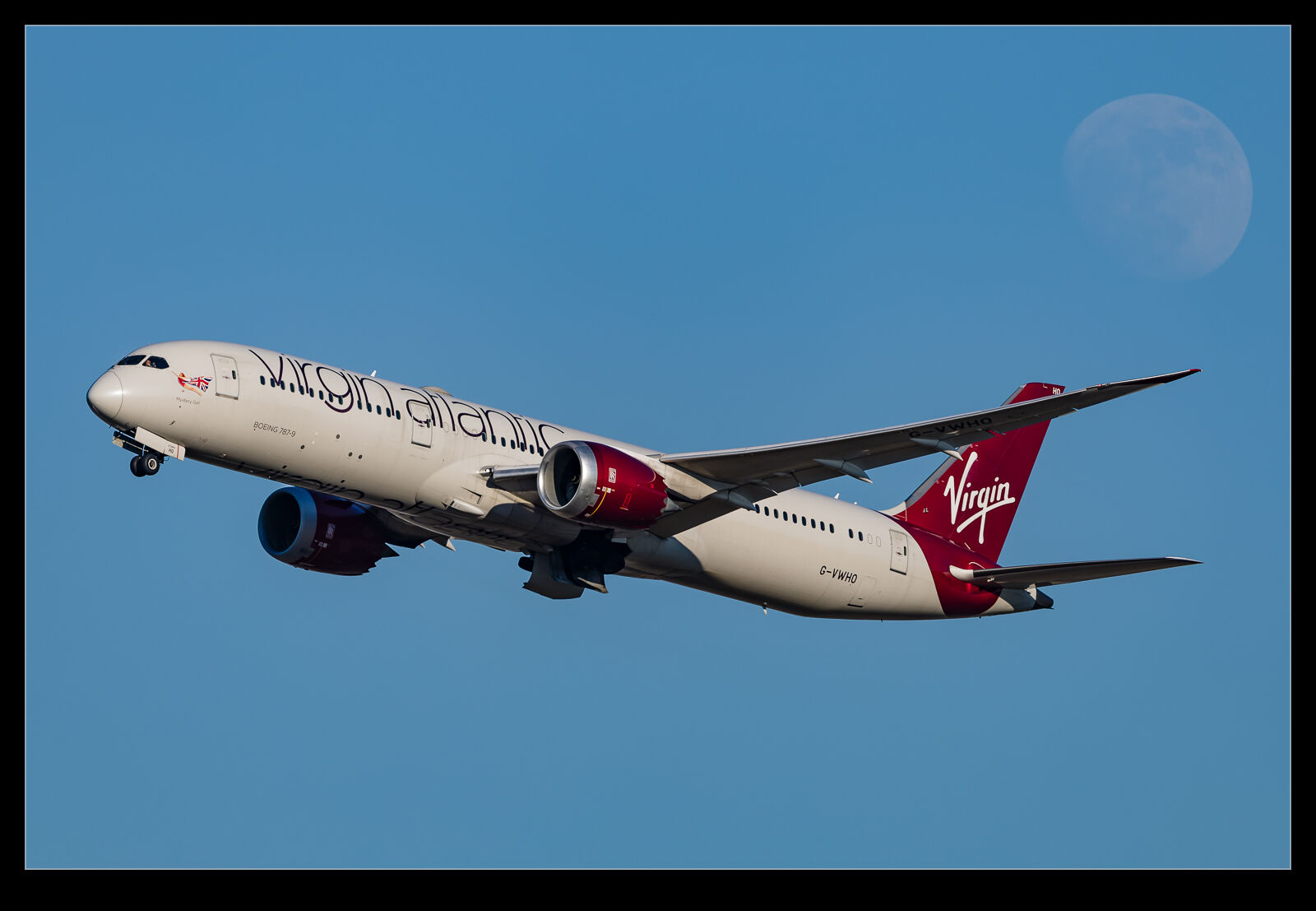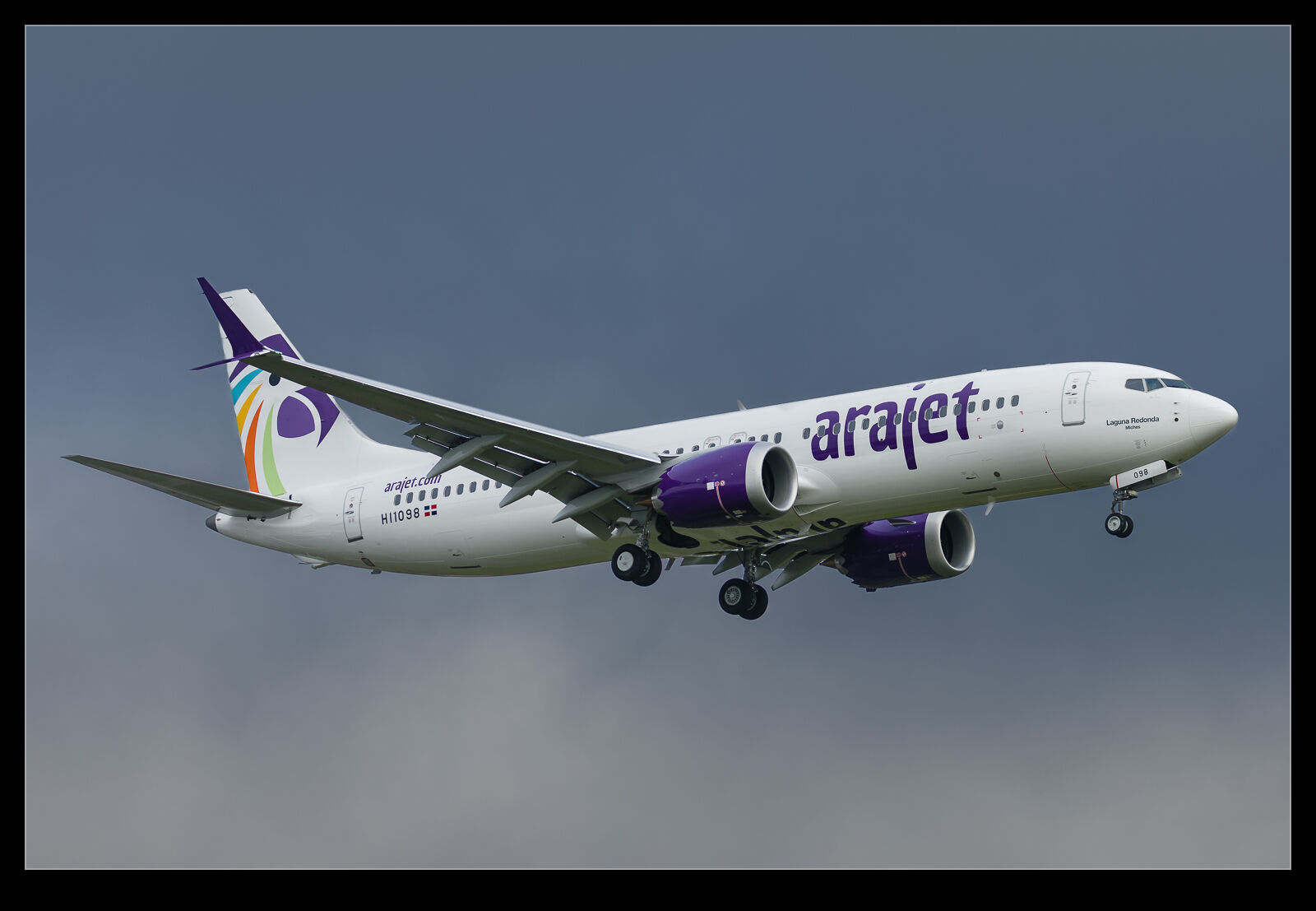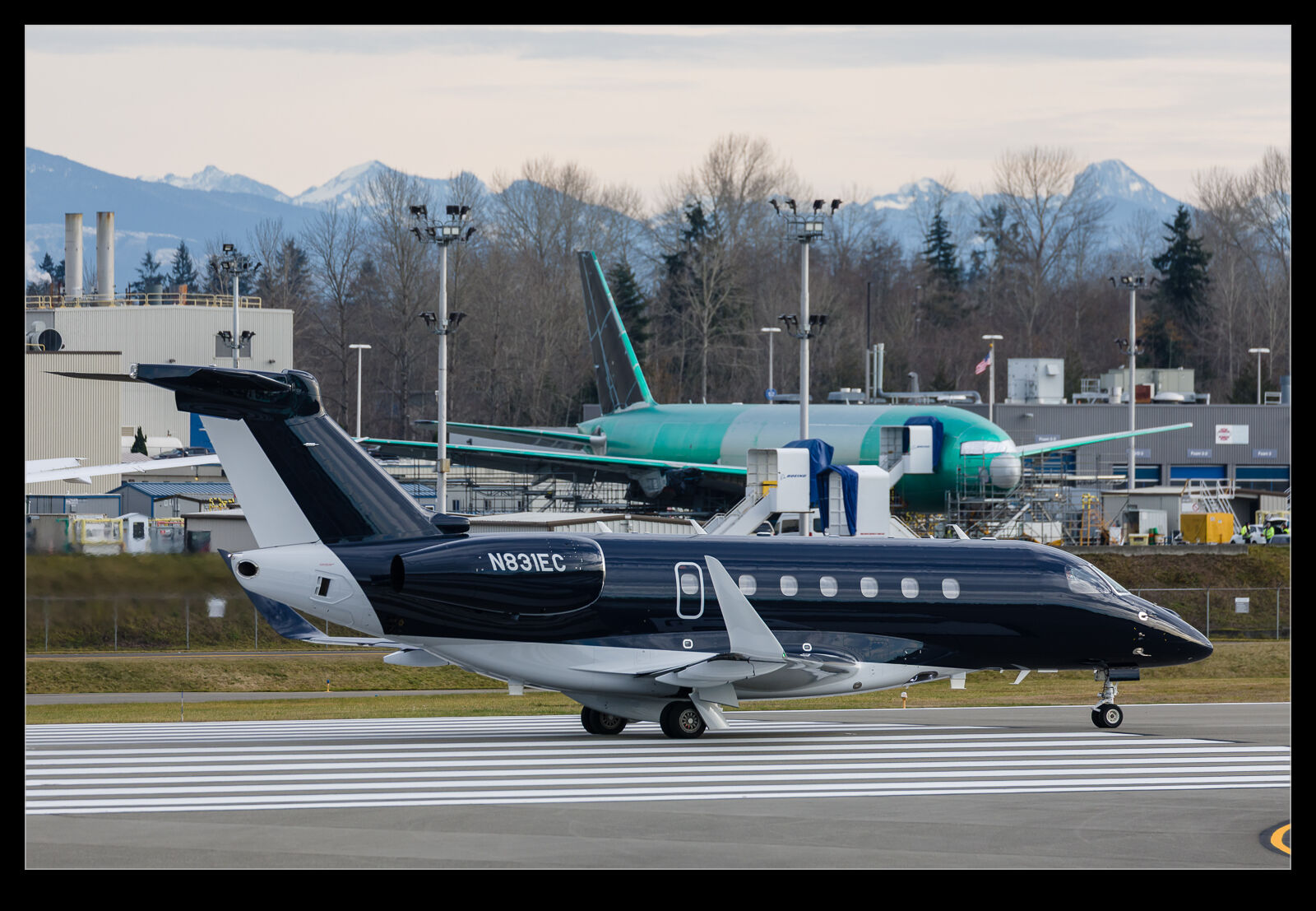 A brief encounter with an Embraer Praetor one weekend at Paine Field for today’s post. I like the Praetor/Legacy jets but one sitting at the threshold might not normally be worth a look. However, this one was painted black and I have a weakness for black painted bizjets. That’s it!
A brief encounter with an Embraer Praetor one weekend at Paine Field for today’s post. I like the Praetor/Legacy jets but one sitting at the threshold might not normally be worth a look. However, this one was painted black and I have a weakness for black painted bizjets. That’s it!
Category Archives: Pacific Northwest
Taking a Chance With the T-38 Landing
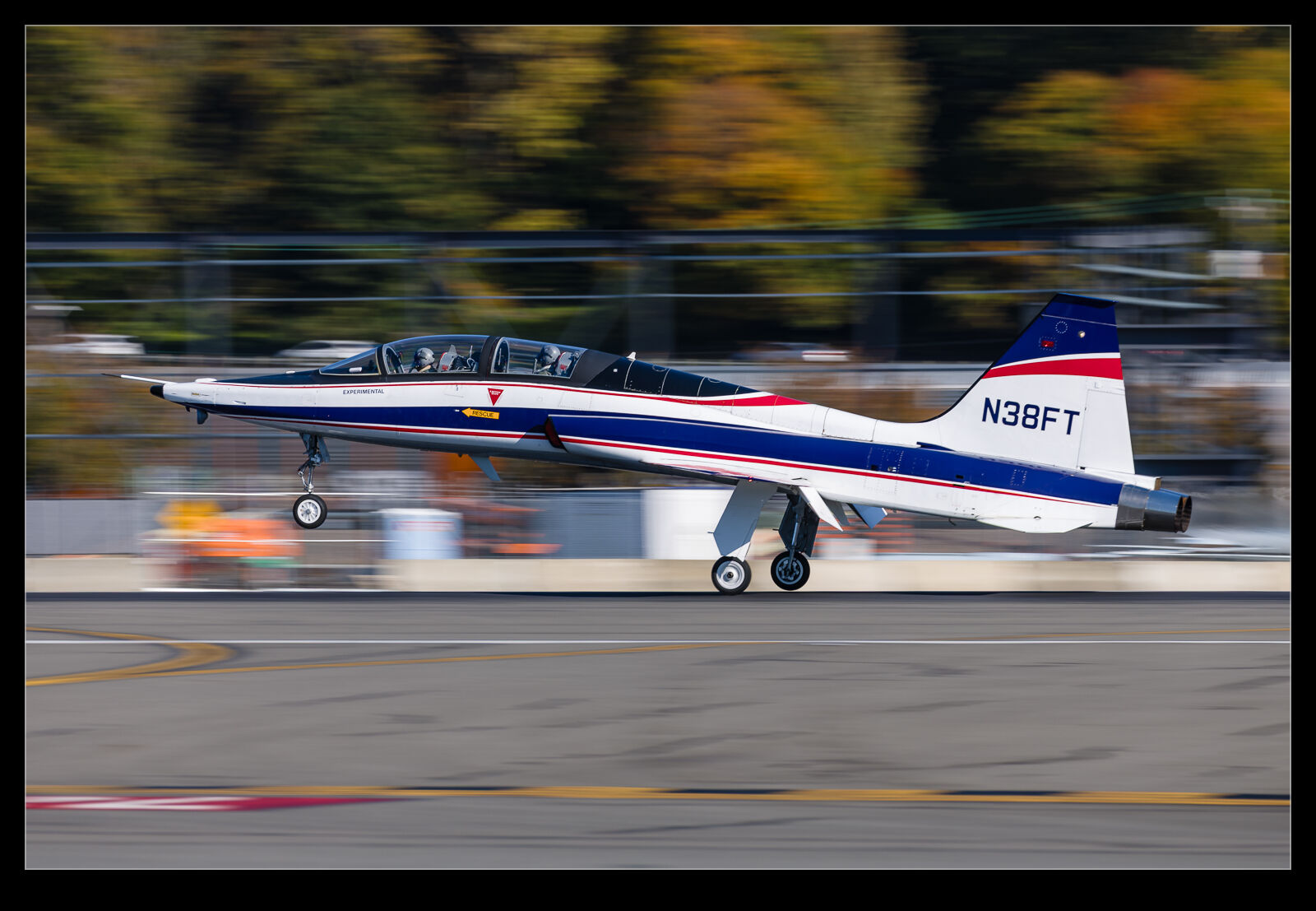 The T-38 chase planes that Boeing operates from Boeing Field did not fly as often as I would have liked. I’m sure they got plenty of use out of them, but it seemed to be a lucky break if one was up – particularly if I was in any place to see them. Consequently, I was always wondering whether I should make sure to get a sharp shot or take a chance on getting a more interesting look to the image. On this occasion, I decided to go with the latter. I dropped the shutter speed down to 1/100th of a second and hoped. A few came out okay. The cluttered background at Boeing Field is always a problem so a bit of blur helps put the focus on the plane.
The T-38 chase planes that Boeing operates from Boeing Field did not fly as often as I would have liked. I’m sure they got plenty of use out of them, but it seemed to be a lucky break if one was up – particularly if I was in any place to see them. Consequently, I was always wondering whether I should make sure to get a sharp shot or take a chance on getting a more interesting look to the image. On this occasion, I decided to go with the latter. I dropped the shutter speed down to 1/100th of a second and hoped. A few came out okay. The cluttered background at Boeing Field is always a problem so a bit of blur helps put the focus on the plane.
Super Bugs at Bremerton
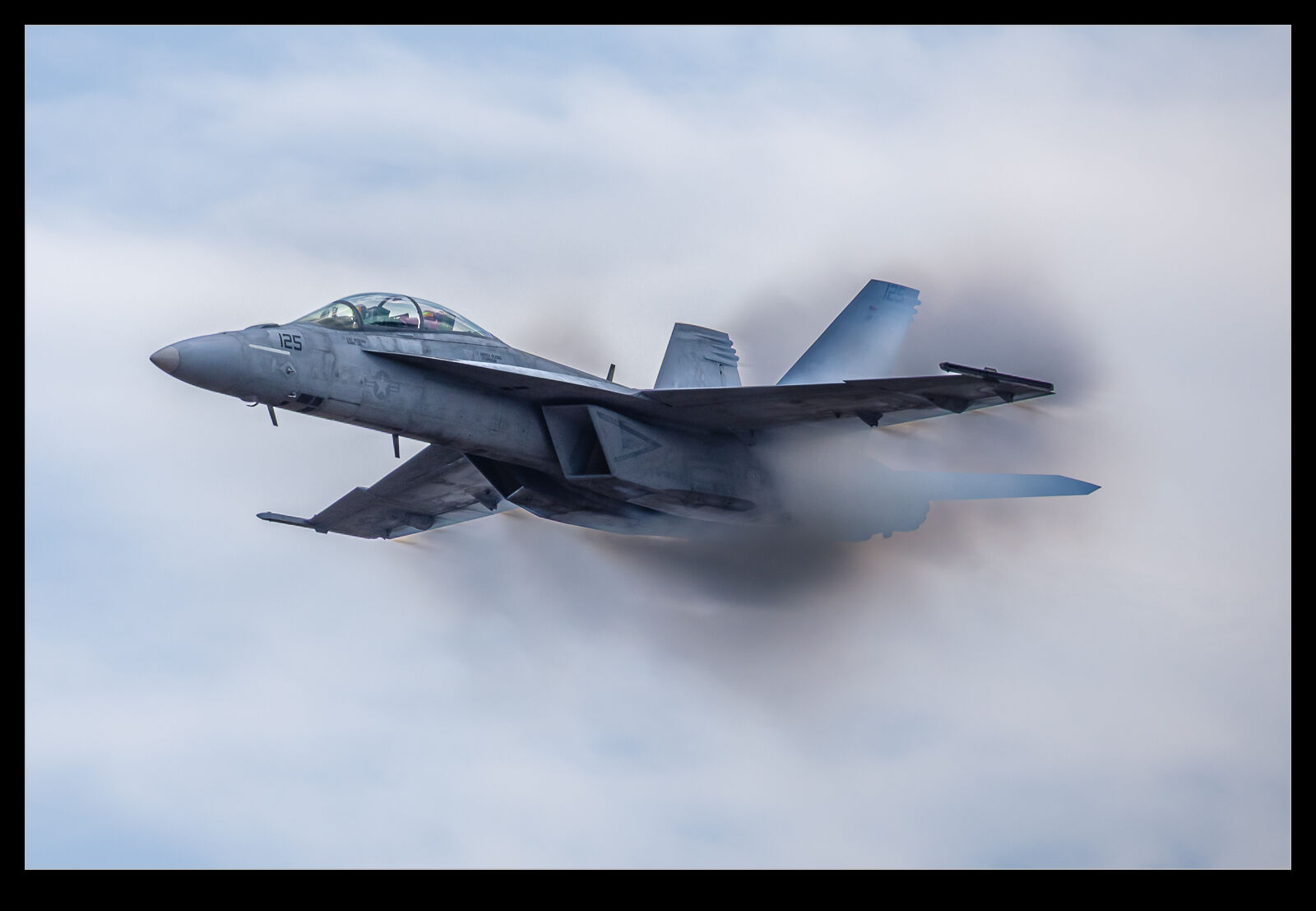 One of the last air shows I attended before we left the Pacific Northwest was at Bremerton. The unusual thing about this air show was that I didn’t head there alone. Instead, Nancy came along with me. It is a long time since she last came to a show with me, but the good news was that she enjoyed it! One of the parts of the show that she found the best was the US Navy’s Super Hornet display. They ripped up the sky for a while. Their blast across the field from crowd rear particularly amused her!
One of the last air shows I attended before we left the Pacific Northwest was at Bremerton. The unusual thing about this air show was that I didn’t head there alone. Instead, Nancy came along with me. It is a long time since she last came to a show with me, but the good news was that she enjoyed it! One of the parts of the show that she found the best was the US Navy’s Super Hornet display. They ripped up the sky for a while. Their blast across the field from crowd rear particularly amused her!
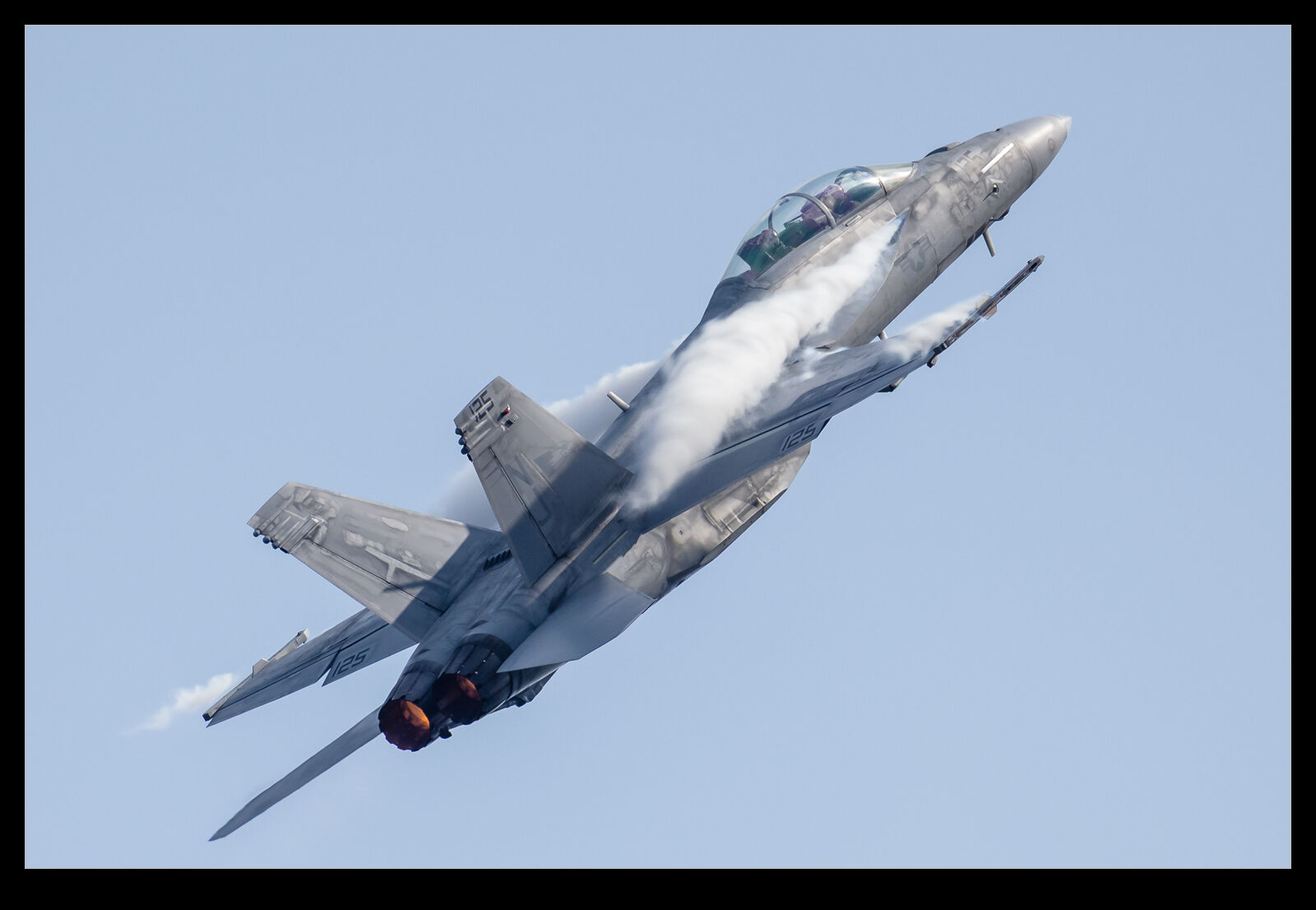 The conditions not ideal from a lighting point of view but there was humidity in the air with the upside that the jet was created plenty of spluff. One of the passes in particular created a lot of cloud activity. It made for a difficult image to process given the contrast with the cloudy background and that its own clouds needed not to be over exposed. I suspect I shall probably try reprocessing this again in the future as either my techniques improve, or the software gets more advanced. I did have a bit too much lens for the closest part of the pass – oh well…
The conditions not ideal from a lighting point of view but there was humidity in the air with the upside that the jet was created plenty of spluff. One of the passes in particular created a lot of cloud activity. It made for a difficult image to process given the contrast with the cloudy background and that its own clouds needed not to be over exposed. I suspect I shall probably try reprocessing this again in the future as either my techniques improve, or the software gets more advanced. I did have a bit too much lens for the closest part of the pass – oh well…
Stormy Sunday Atlas 777F
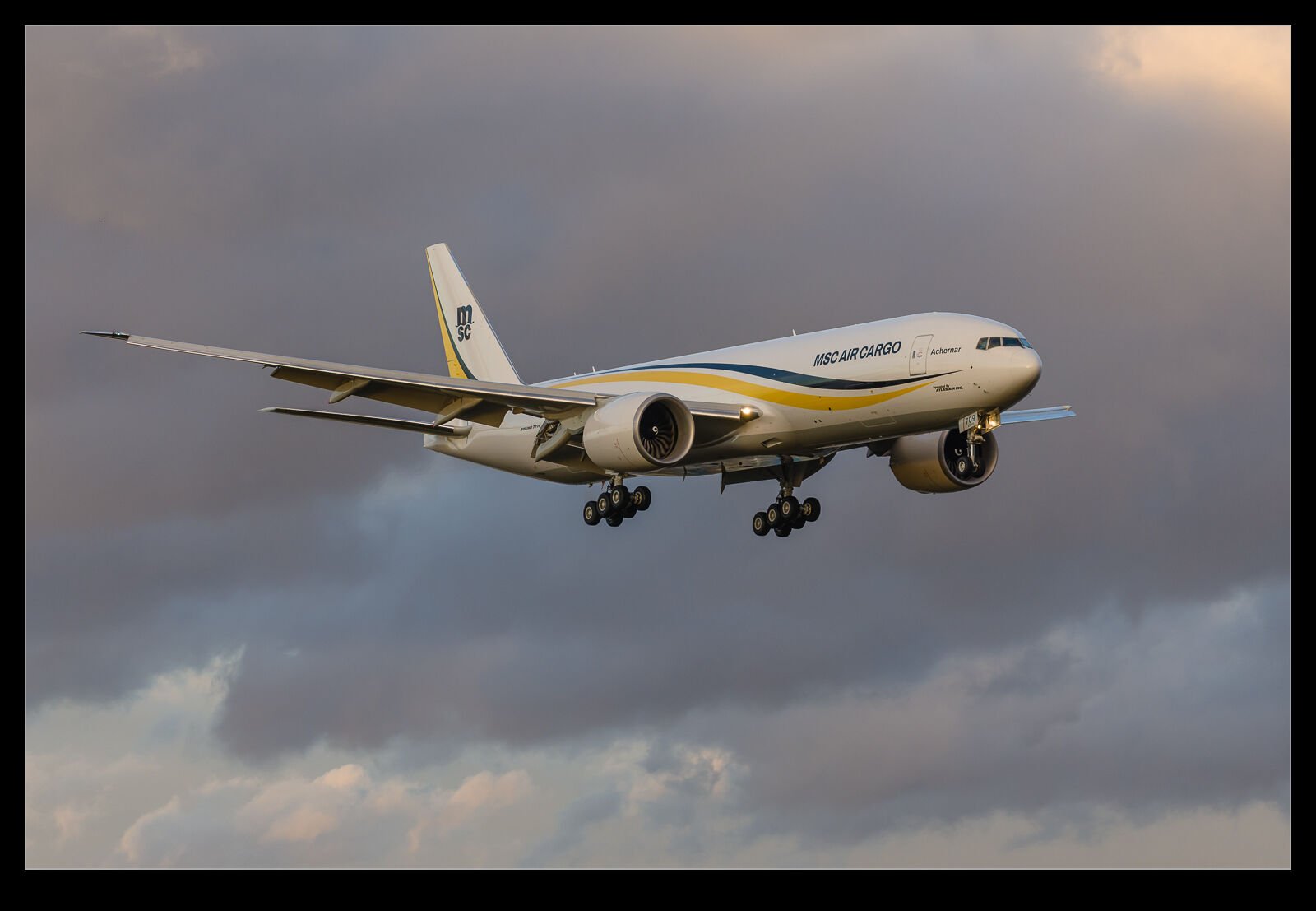 A stormy sky doesn’t immediately inspire you when going for some aircraft photography but, if the light on the subject can end up being okay, a dark background can suddenly seem like a great option. One Sunday an Atlas 777F was up on test at Paine Field. The sky was dark and gloomy but not a solid cloud background. Instead, the clouds were stratified so there was more detail and texture to see.
A stormy sky doesn’t immediately inspire you when going for some aircraft photography but, if the light on the subject can end up being okay, a dark background can suddenly seem like a great option. One Sunday an Atlas 777F was up on test at Paine Field. The sky was dark and gloomy but not a solid cloud background. Instead, the clouds were stratified so there was more detail and texture to see.
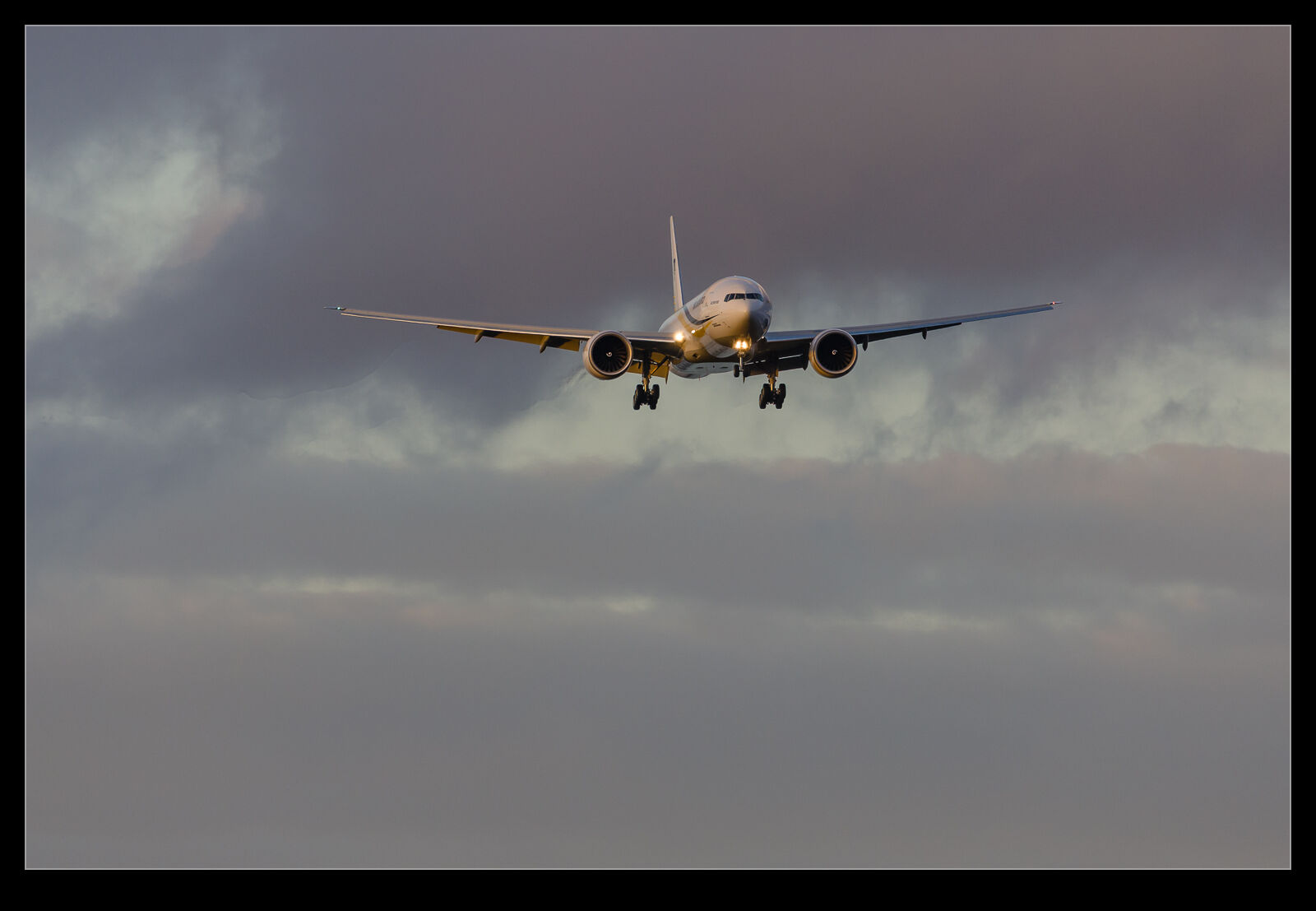 As the 777 came down the approach, it was not brightly illuminated but it was picking up a good amount of light compared to what I had expected to be the case. This did require some thought about the camera settings. When the sky is dark, I often significantly over-expose. This is because the clouds will dominate the metering response and the subject – which is usually quite dark – really disappears. In post processing I can then bring the exposure back down but there is sufficient light on the subject to get a good image of it against the sky.
As the 777 came down the approach, it was not brightly illuminated but it was picking up a good amount of light compared to what I had expected to be the case. This did require some thought about the camera settings. When the sky is dark, I often significantly over-expose. This is because the clouds will dominate the metering response and the subject – which is usually quite dark – really disappears. In post processing I can then bring the exposure back down but there is sufficient light on the subject to get a good image of it against the sky.
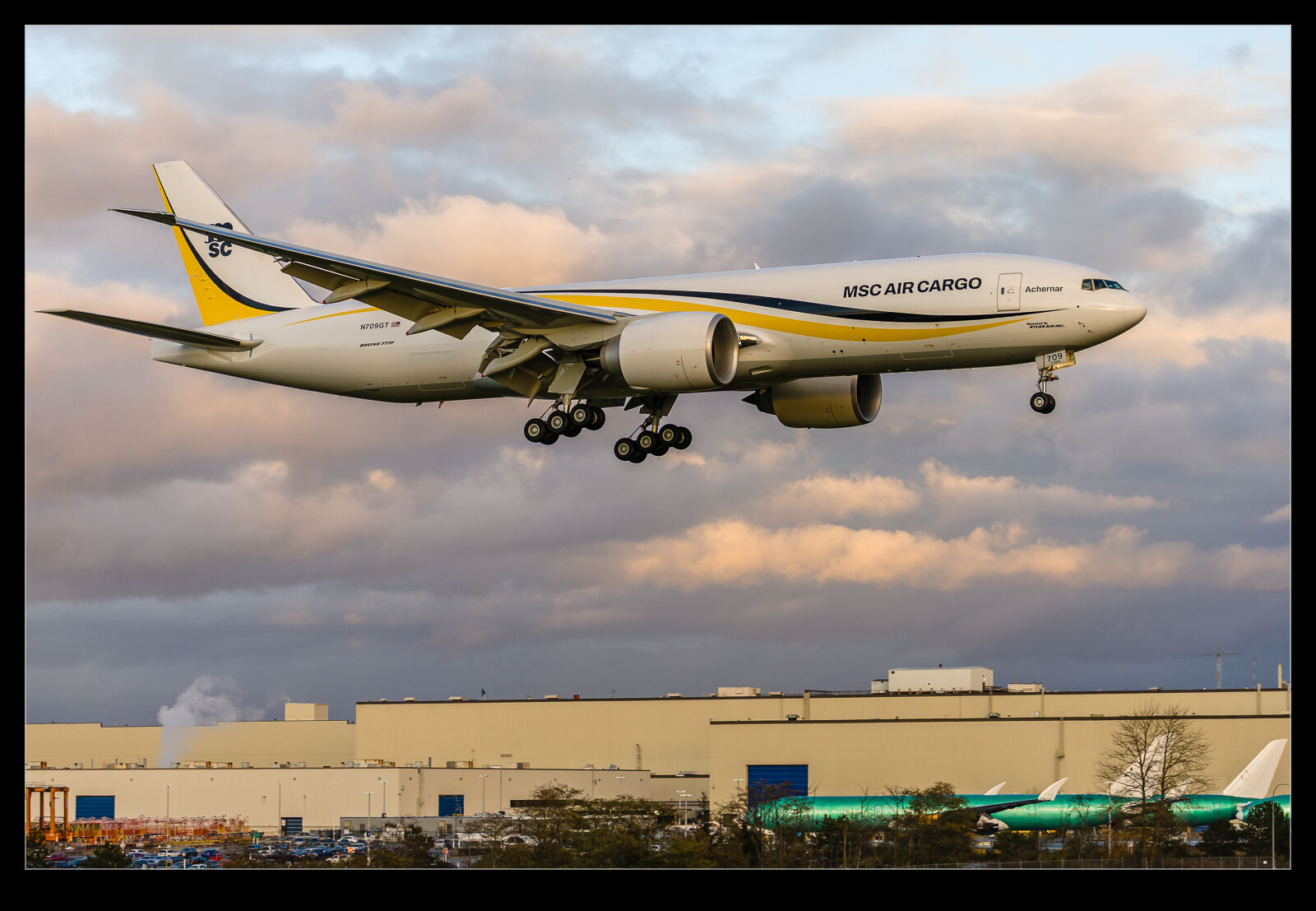 In this case, I had to be more careful. With good light on the subject, the dark sky would result in blowing out the plane. Therefore, I had to keep the exposure compensation off to allow the subject to not get too overexposed and not leave enough latitude for processing it to where I wanted it to be. The results came out okay. This was more important for the longer shots. Once the plane was close in, it started to dominate the metering response and, once on the ground, the illumination was more balanced.
In this case, I had to be more careful. With good light on the subject, the dark sky would result in blowing out the plane. Therefore, I had to keep the exposure compensation off to allow the subject to not get too overexposed and not leave enough latitude for processing it to where I wanted it to be. The results came out okay. This was more important for the longer shots. Once the plane was close in, it started to dominate the metering response and, once on the ground, the illumination was more balanced.
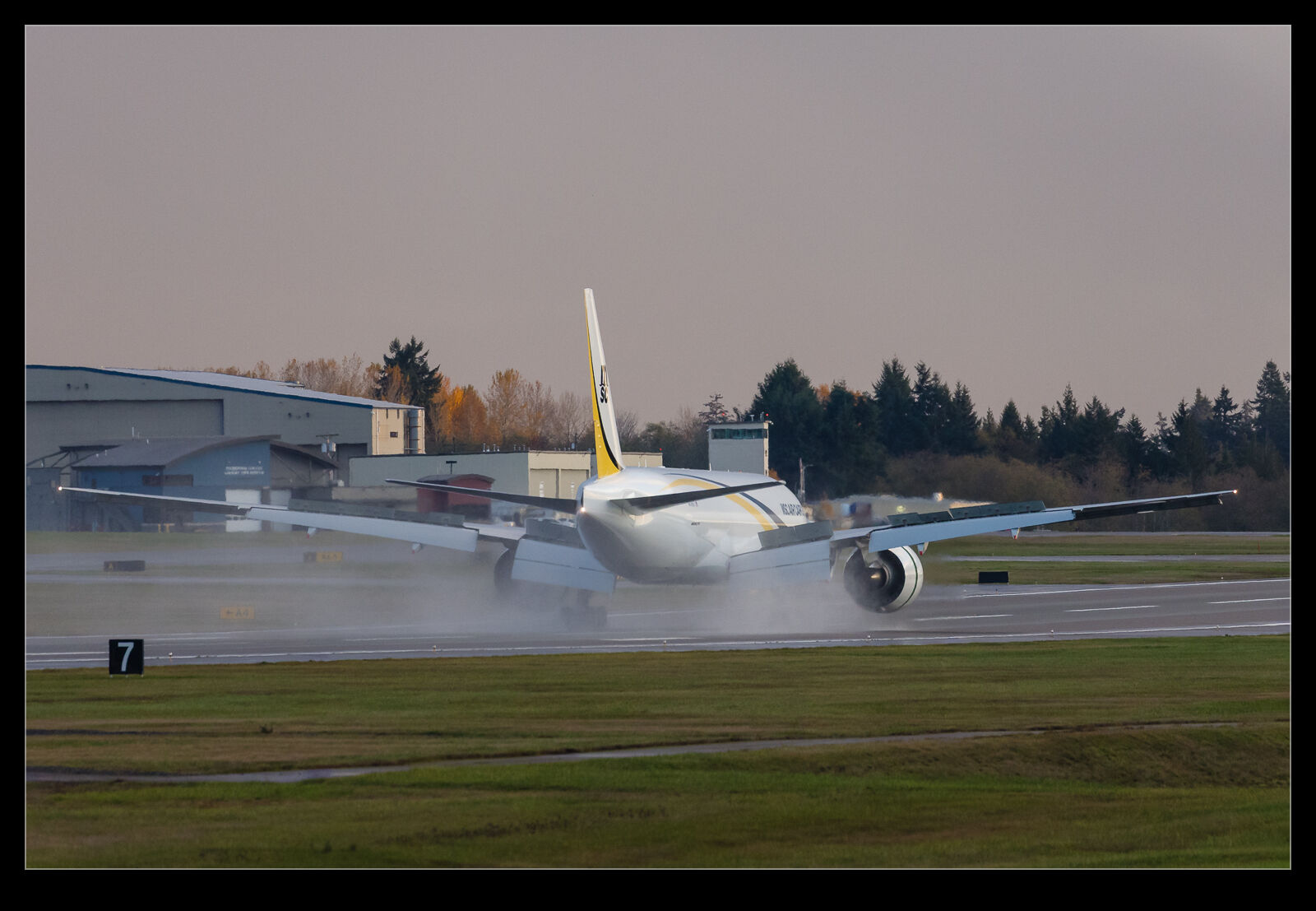 Once they touched down and brought in the reversers, you could see that the conditions had not long ago been wet as the runway still had plenty of water on the surface and the reversers kicked it up in the air.
Once they touched down and brought in the reversers, you could see that the conditions had not long ago been wet as the runway still had plenty of water on the surface and the reversers kicked it up in the air.
The Gloomy Conditions Make the Cockpit Displays Visible
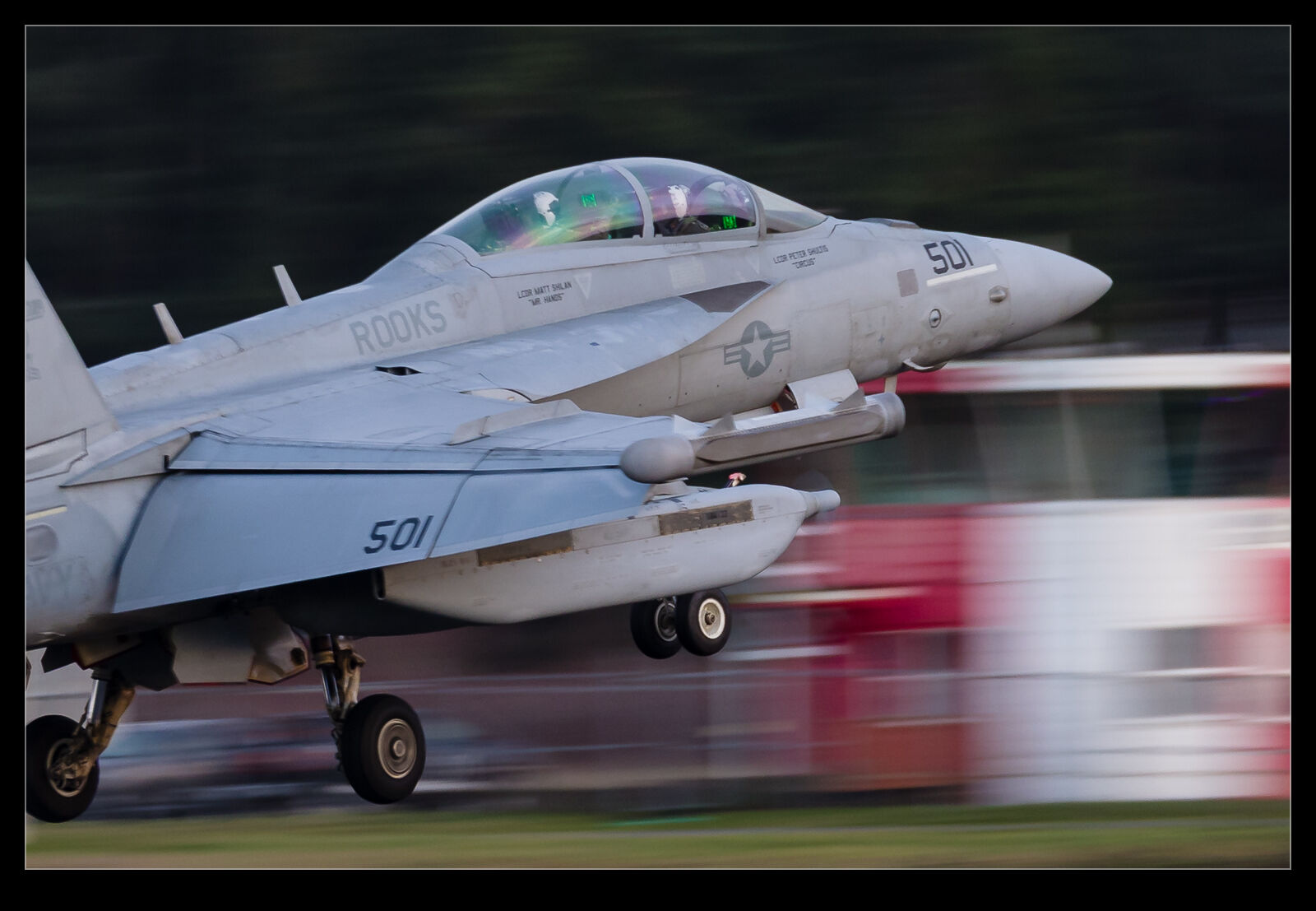 Back on one of my last visits to Coupeville to watch the Growlers undertaking FCLP, the weather was not playing ball and things ended up getting quite gloomy at the end of the slots they had planned. With a modern camera, this is not really an issue as you can handle some really low light without too much compromise. However, the thing I did notice as I was going through the images was that the green colours of the cockpit displays really start to show up. In some of the earlier shots, the light in the sky was reflecting off the canopy which washed it out a touch but by the last few passes, the green was really showing up.
Back on one of my last visits to Coupeville to watch the Growlers undertaking FCLP, the weather was not playing ball and things ended up getting quite gloomy at the end of the slots they had planned. With a modern camera, this is not really an issue as you can handle some really low light without too much compromise. However, the thing I did notice as I was going through the images was that the green colours of the cockpit displays really start to show up. In some of the earlier shots, the light in the sky was reflecting off the canopy which washed it out a touch but by the last few passes, the green was really showing up.
Reverse Thrust Bizjets
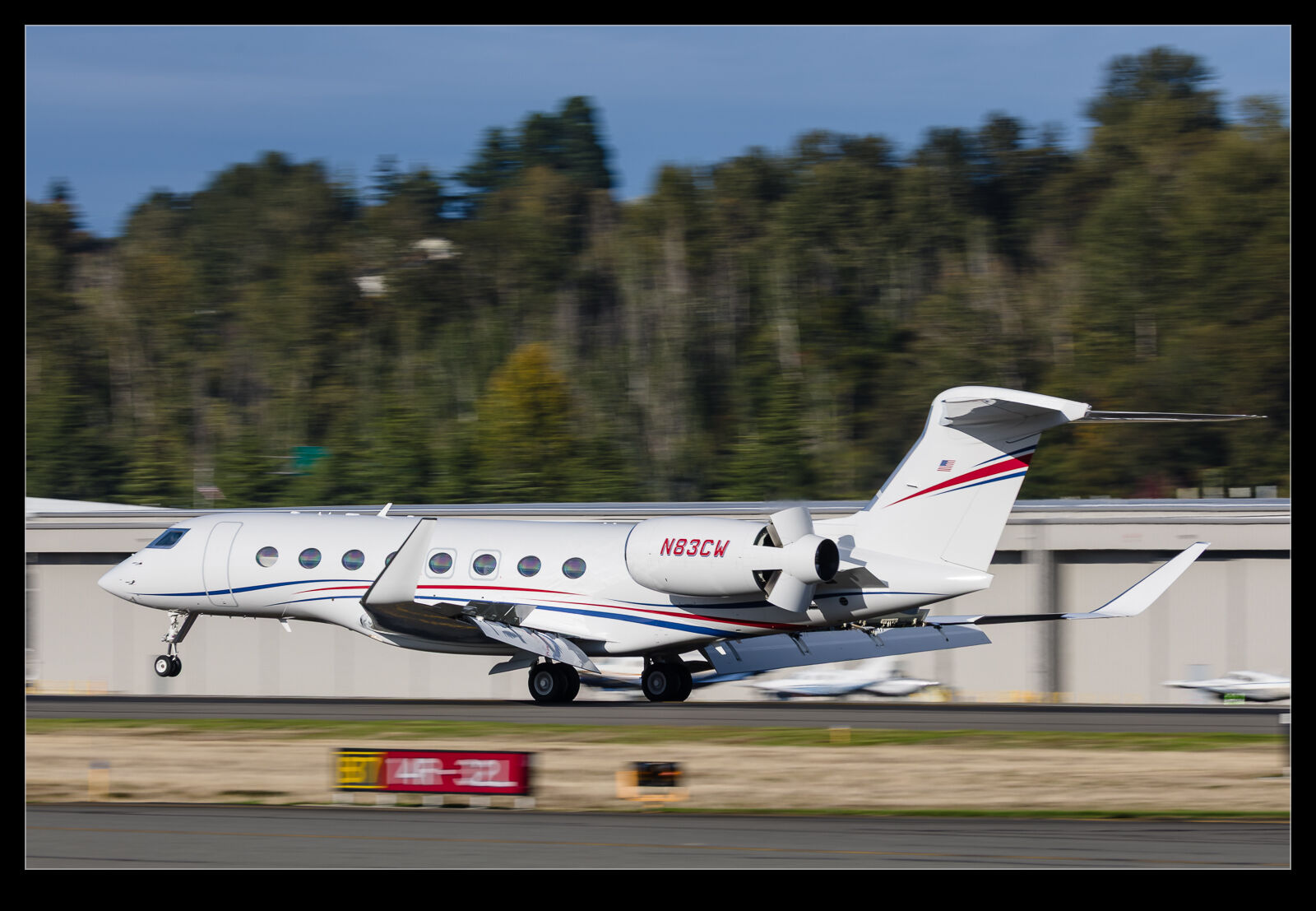 Boeing Field is busy with business jets and some of them are more interesting than others. However, one thing that does catch my attention is the use of reverse thrust. On bizjets, it is often used for braking when taxiing to keep the brakes cooler. Of course, it is used for landings. Usually, the reversers are stowed as the jet slows but other times they are left in until they have vacated the runway. Here is a selection of jets with their reversers in use.
Boeing Field is busy with business jets and some of them are more interesting than others. However, one thing that does catch my attention is the use of reverse thrust. On bizjets, it is often used for braking when taxiing to keep the brakes cooler. Of course, it is used for landings. Usually, the reversers are stowed as the jet slows but other times they are left in until they have vacated the runway. Here is a selection of jets with their reversers in use.
Catching an Evolution in the Gloom
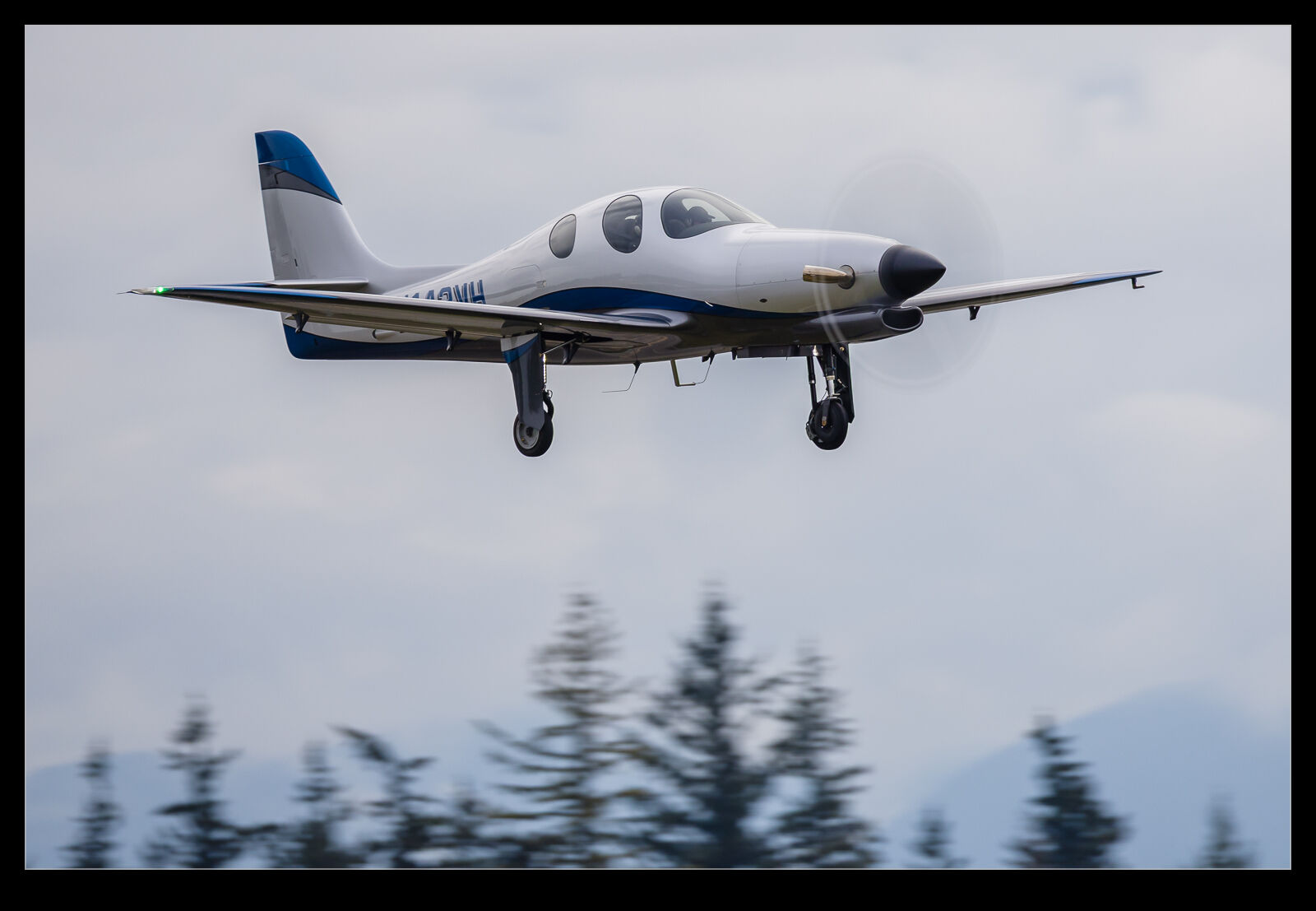 The Lancair Evolution is not a particularly common aircraft although I have come across examples over the years. However, one slightly gloomy Sunday afternoon, I saw that one was heading to Paine Field. I understand that it might be locally based but I hadn’t seen it before and, with not a lot else going on, made the short trip up to Everett. On jaunts like this, you start persuading yourself that the clouds are going to part at just the right moment and then the sun will illuminate your subject against a dark and foreboding sky.
The Lancair Evolution is not a particularly common aircraft although I have come across examples over the years. However, one slightly gloomy Sunday afternoon, I saw that one was heading to Paine Field. I understand that it might be locally based but I hadn’t seen it before and, with not a lot else going on, made the short trip up to Everett. On jaunts like this, you start persuading yourself that the clouds are going to part at just the right moment and then the sun will illuminate your subject against a dark and foreboding sky.
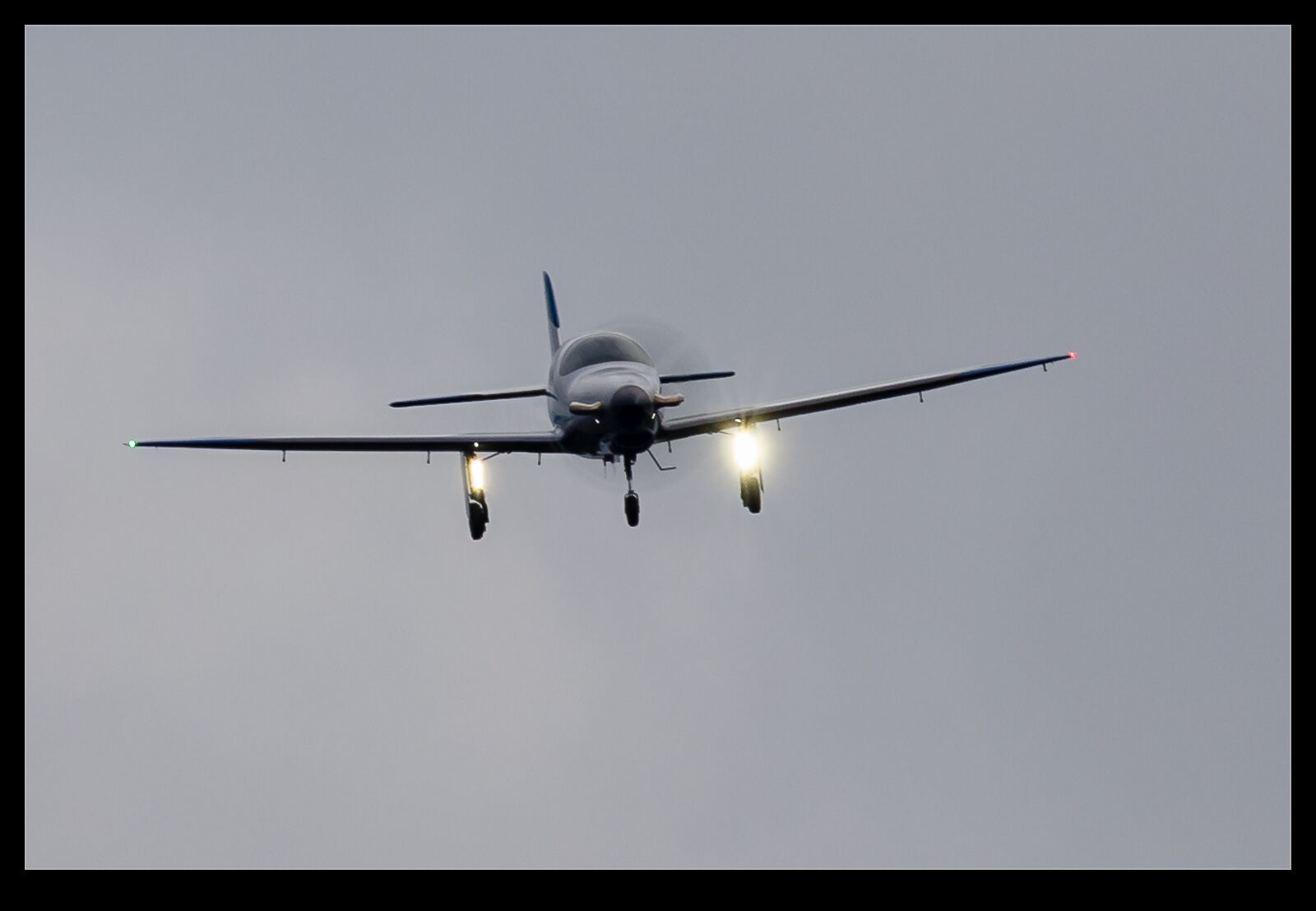 That has worked for me on occasion but this was not such an occasion. The conditions were still pretty dull when they showed up on approach. As is often my technique in these conditions, I shot quite heavily over-exposed. This allows for lots of detail in the aircraft to be captured and then for some masking of the background to bring it back down to something resembling what it actually was on the day. The eye does such a good job of dealing with dynamic range that it is amazing to see just how badly the exposures can vary in conditions like this. Getting the most of the data from the initial image and then letting the post processing techniques bring it back to what you actually saw is the way I like to go. This plane flew quite a bit after this day but never when I had a chance to catch it again so no sunny shots of it I’m afraid.
That has worked for me on occasion but this was not such an occasion. The conditions were still pretty dull when they showed up on approach. As is often my technique in these conditions, I shot quite heavily over-exposed. This allows for lots of detail in the aircraft to be captured and then for some masking of the background to bring it back down to something resembling what it actually was on the day. The eye does such a good job of dealing with dynamic range that it is amazing to see just how badly the exposures can vary in conditions like this. Getting the most of the data from the initial image and then letting the post processing techniques bring it back to what you actually saw is the way I like to go. This plane flew quite a bit after this day but never when I had a chance to catch it again so no sunny shots of it I’m afraid.
Getting the Moon in Some Shots
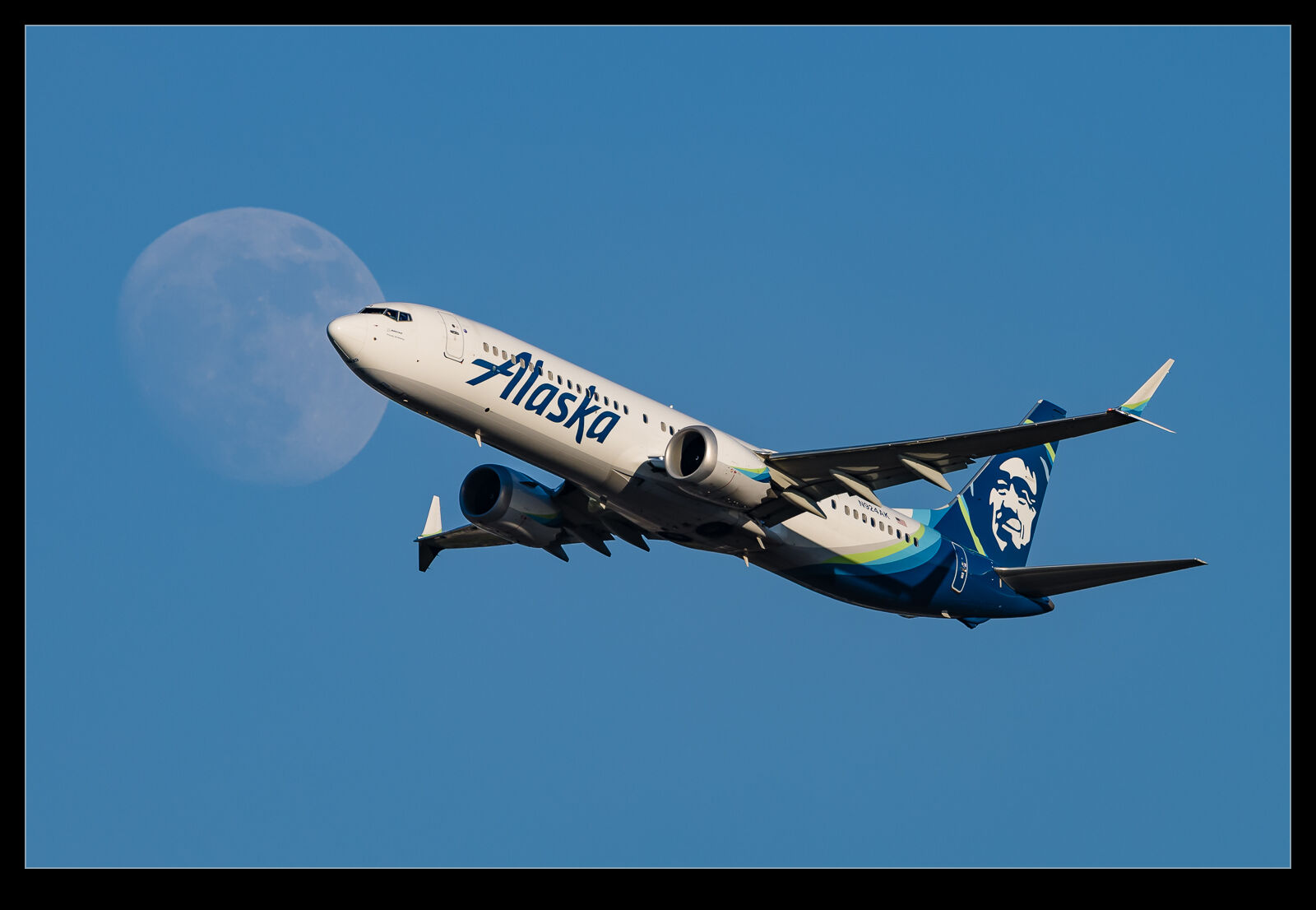 If you are shooting at the time of the month when the moon is close to full, it should mean it will show up in the background at some point when you have afternoon/evening light behind you. Will it make it into your shot? Probably not. The angles the planes take vary and the moon is constantly moving in the background so, while you can anticipate it might work out at some point and hope accordingly, that doesn’t mean it will work. Of course, you can also forget about it for a while and miss a perfectly good moon shot too – who would do that though?
If you are shooting at the time of the month when the moon is close to full, it should mean it will show up in the background at some point when you have afternoon/evening light behind you. Will it make it into your shot? Probably not. The angles the planes take vary and the moon is constantly moving in the background so, while you can anticipate it might work out at some point and hope accordingly, that doesn’t mean it will work. Of course, you can also forget about it for a while and miss a perfectly good moon shot too – who would do that though?
 At various times when shooting departures are Seattle Tacoma International Airport, I did get the moon to show up in the shots. Would it be with the most interesting aircraft in the foreground? Probably not. More likely to be an Alaska Airlines jet since they are the most common departure (and also the one more likely to have made me not be getting a shot) but that is still fine. Here are some results from across various shoots.
At various times when shooting departures are Seattle Tacoma International Airport, I did get the moon to show up in the shots. Would it be with the most interesting aircraft in the foreground? Probably not. More likely to be an Alaska Airlines jet since they are the most common departure (and also the one more likely to have made me not be getting a shot) but that is still fine. Here are some results from across various shoots.
An Epic Skirting the Sun
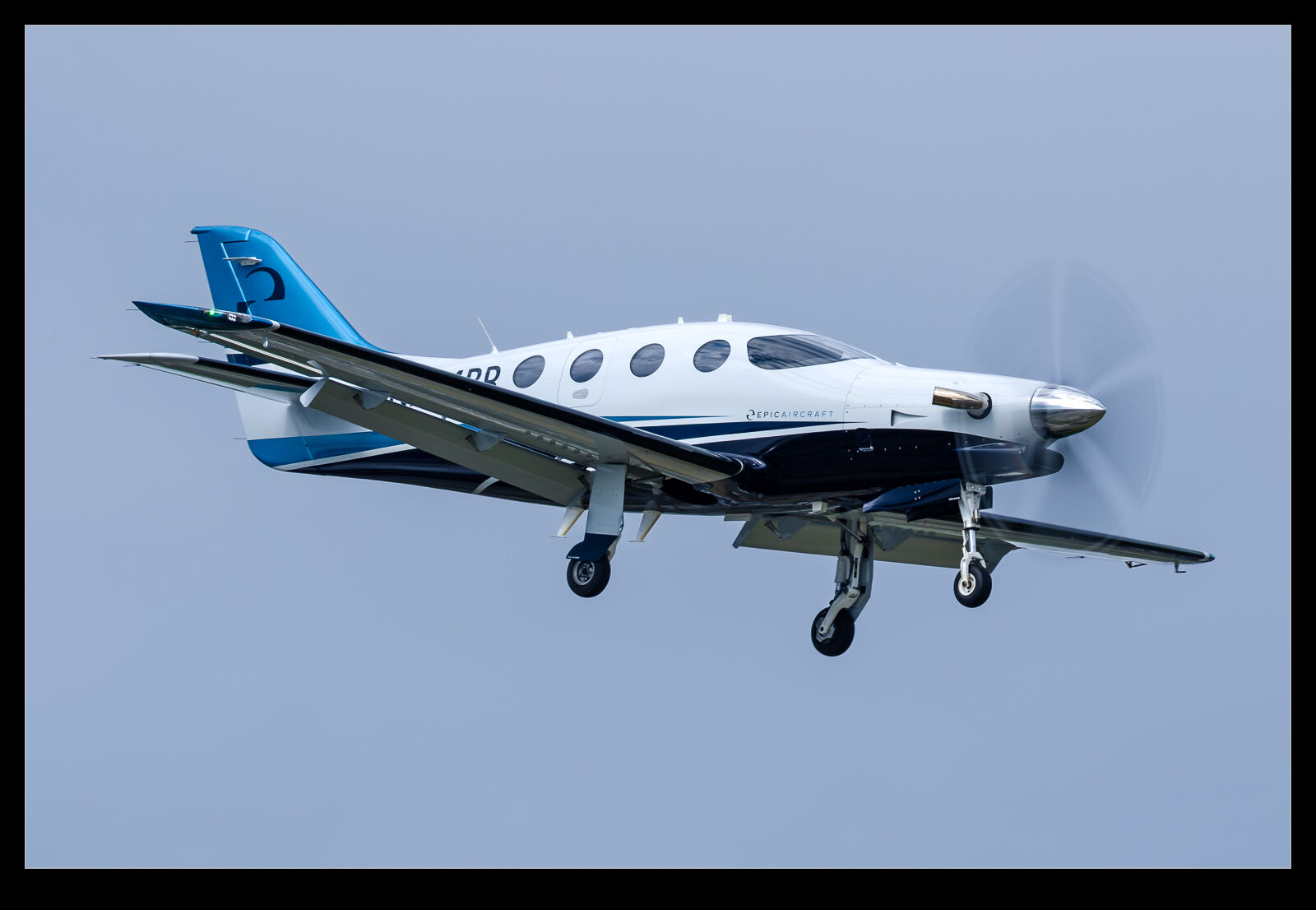 Epic E1000s have shown up on the blog before and in less than ideal conditions. Sometimes you just have to work with what is available. It doesn’t stop me trying, of course, and when another one was due in to Boeing Field and the conditions looked promising, I headed out. When I was in place and they were getting closer, the sun was playing games with me. I would have some nice light for a while and then the clouds would drift back in again. They wouldn’t stay long and then sun would be back but the question was, what would it be like at the critical moment. At Boeing Field, I have often had good light further up the approach (and too far away), cloud over the ideal location and then sun again as they get to very short final but again too far for a decent shot. Would this be one of those days?
Epic E1000s have shown up on the blog before and in less than ideal conditions. Sometimes you just have to work with what is available. It doesn’t stop me trying, of course, and when another one was due in to Boeing Field and the conditions looked promising, I headed out. When I was in place and they were getting closer, the sun was playing games with me. I would have some nice light for a while and then the clouds would drift back in again. They wouldn’t stay long and then sun would be back but the question was, what would it be like at the critical moment. At Boeing Field, I have often had good light further up the approach (and too far away), cloud over the ideal location and then sun again as they get to very short final but again too far for a decent shot. Would this be one of those days?
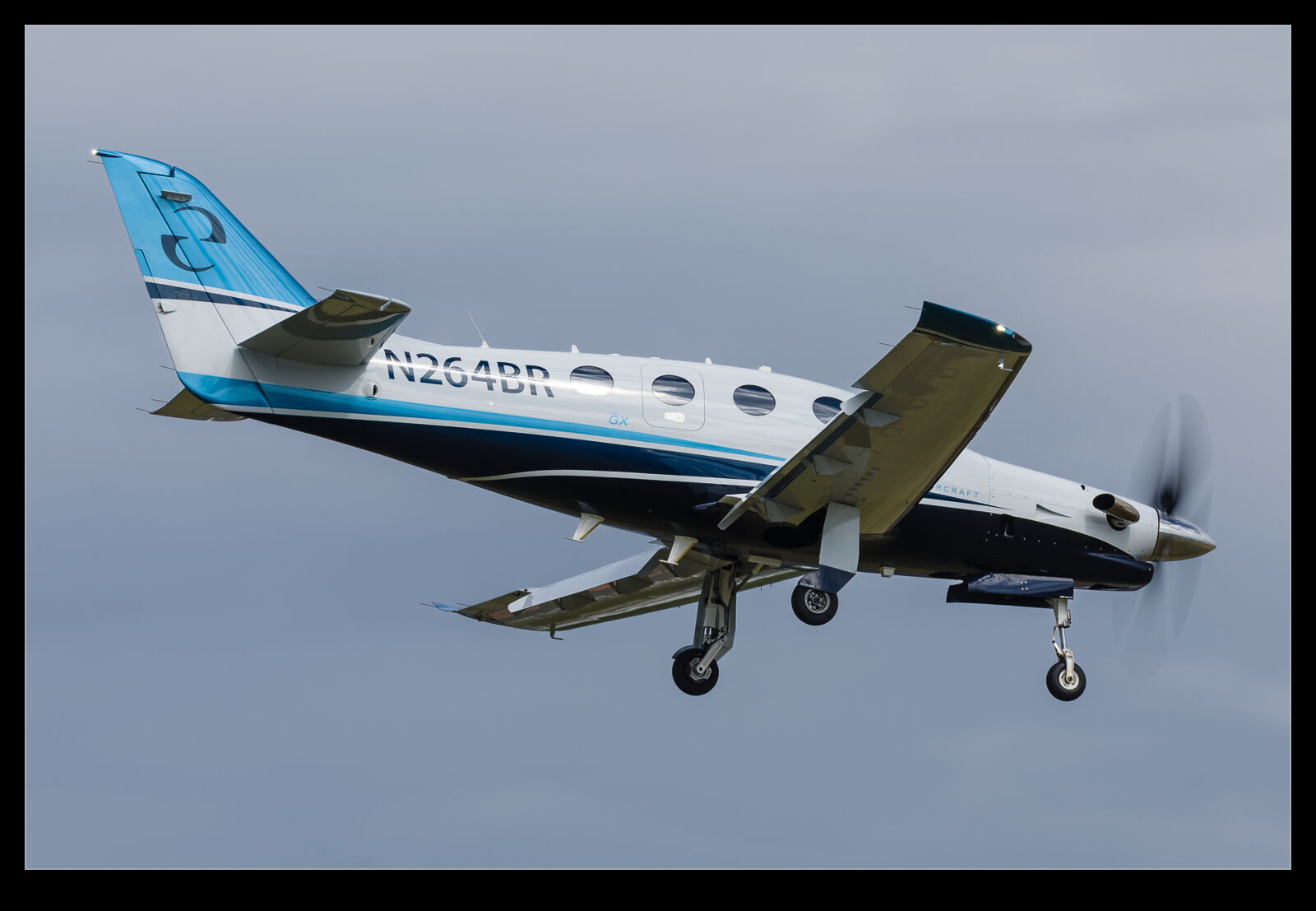 No! On this occasion, the conditions played ball and, as the E1000 came zipping down the approach, the sun was out in all the right places. I grabbed some shots and the blues in the paint really did seem to pop. I was quite satisfied. I did get one more Epic encounter at BFI before we moved away which was from the other end providing a different type of shot in good light but, after that, while there were lots of movements to BFI before we left, I didn’t have the chance to see them.
No! On this occasion, the conditions played ball and, as the E1000 came zipping down the approach, the sun was out in all the right places. I grabbed some shots and the blues in the paint really did seem to pop. I was quite satisfied. I did get one more Epic encounter at BFI before we moved away which was from the other end providing a different type of shot in good light but, after that, while there were lots of movements to BFI before we left, I didn’t have the chance to see them.
Arajet But Without the Paint
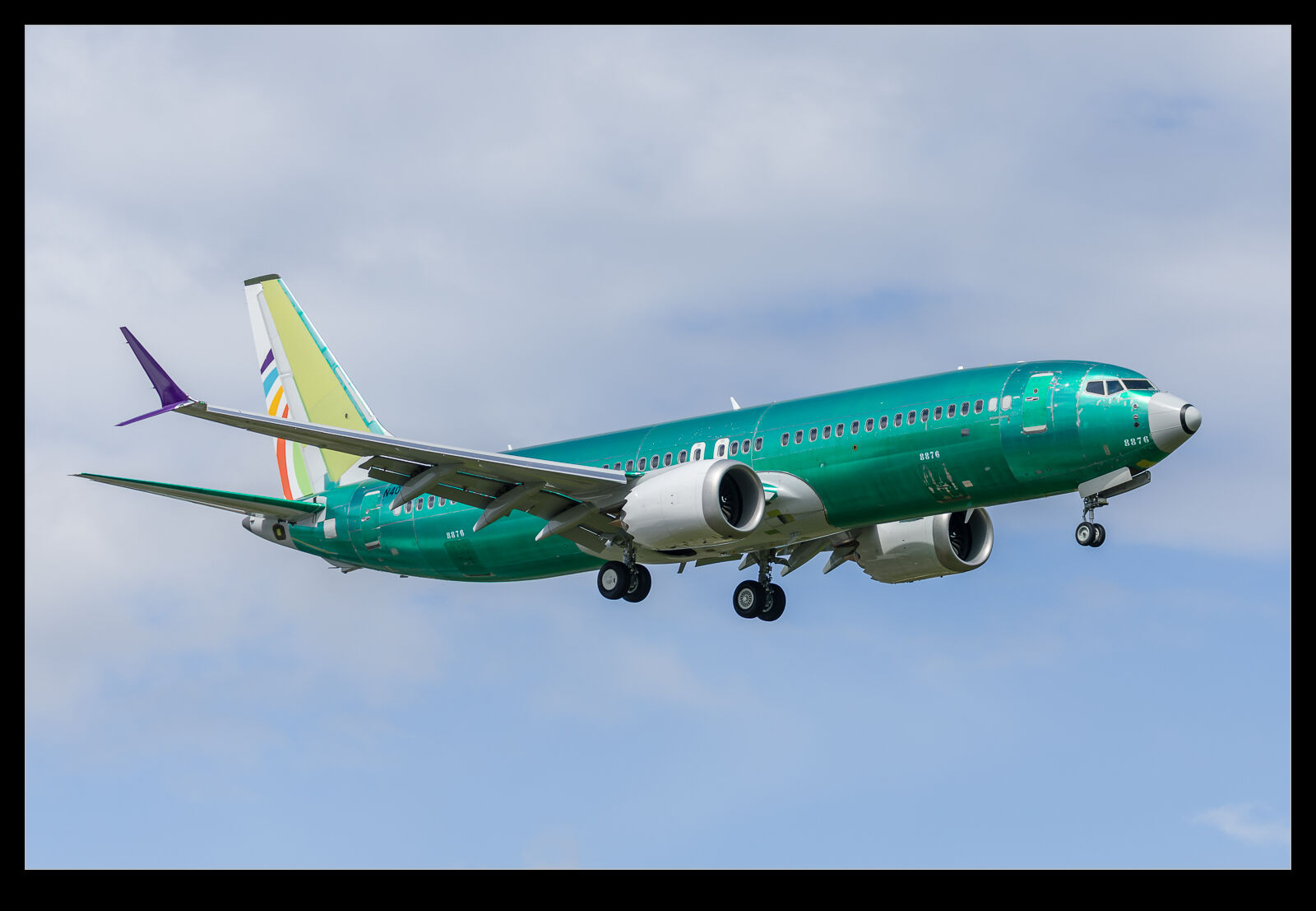 Having Boeing on your doorstep means the chance to photograph airlines that you have a good chance of never seeing in their normal operations. Arajet, of the Dominican Republic, is one such airline. As they were taking delivery of some 737 Max jets, I was able to photograph them. On one occasion, I was out at Boeing Field when one of their jets was on test and I was looking forward to getting a shot. Unfortunately, I didn’t know it hadn’t yet been painted. Instead, I got a green plane with only the rudder and winglets giving away who the ultimate operator would be
Having Boeing on your doorstep means the chance to photograph airlines that you have a good chance of never seeing in their normal operations. Arajet, of the Dominican Republic, is one such airline. As they were taking delivery of some 737 Max jets, I was able to photograph them. On one occasion, I was out at Boeing Field when one of their jets was on test and I was looking forward to getting a shot. Unfortunately, I didn’t know it hadn’t yet been painted. Instead, I got a green plane with only the rudder and winglets giving away who the ultimate operator would be
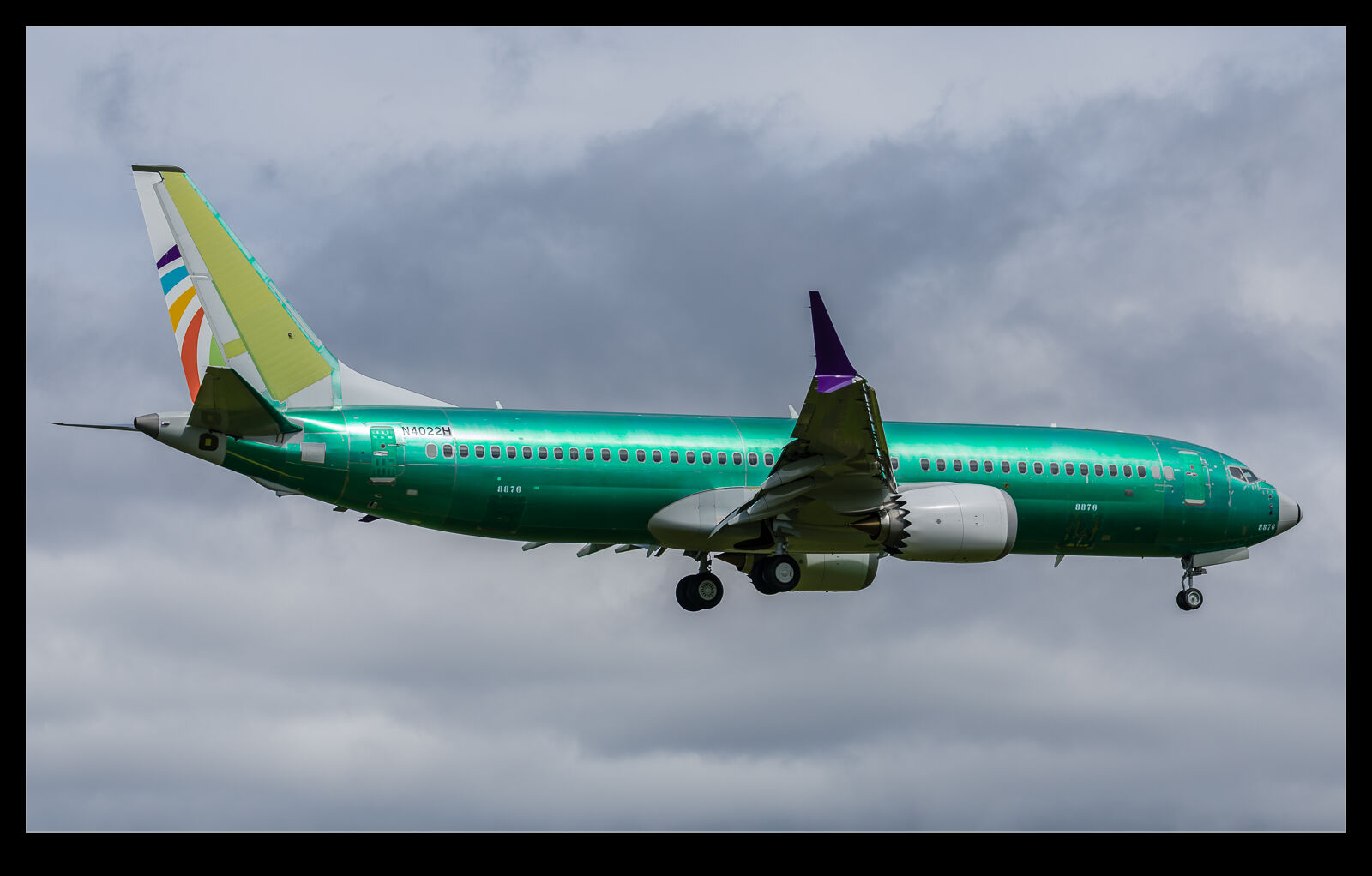 I like the green of the unpainted jets and primer finishes on other planes also look good to me. I wasn’t so upset as a result, but it wasn’t exactly what I was hoping for. Still, it looked pretty good on approach. I did get another airframe in the finished livery so I will stick that at the bottom to show what this one would ultimately look like. Not a dramatic livery but something different.
I like the green of the unpainted jets and primer finishes on other planes also look good to me. I wasn’t so upset as a result, but it wasn’t exactly what I was hoping for. Still, it looked pretty good on approach. I did get another airframe in the finished livery so I will stick that at the bottom to show what this one would ultimately look like. Not a dramatic livery but something different.

